Add your feed to SetSticker.com! Promote your sites and attract more customers. It costs only 100 EUROS per YEAR.
Pleasant surprises on every page! Discover new articles, displayed randomly throughout the site. Interesting content, always a click away
Find Asia – Tours in Asia
Find tours in your destinationsGöbekli Tepe from Istanbul 26 Jan 2025, 11:53 am
How you can get to Göbekli Tepe from Istanbul?
There are several ways to get to Göbekli Tepe from Istanbul:
- By plane and car: Fly from Istanbul to Şanlıurfa Airport, then drive or take a taxi to Göbekli Tepe. Turkish Airlines operates daily flights from Istanbul to Şanlıurfa. The archaeological site is located about 15 km northeast of Şanlıurfa.
- Organized day trip: Book a day trip from Istanbul that includes round-trip flights, transportation, and guided tours. These trips typically include pickup from your hotel in Istanbul, flights to Şanlıurfa, and transportation to Göbekli Tepe. For example, Istanbul: Gobeklitepe and Harran Day Trip is a reasonably priced good tour.
- By bus: Take a long-distance bus from Istanbul Esenler bus station to Şanlıurfa bus station, which takes approximately 17 hours and 45 minutes. From Şanlıurfa, you can then arrange local transportation to Göbekli Tepe.
- Self-drive: Rent a car in Istanbul and drive to Göbekli Tepe. This option provides flexibility but requires a long journey.
From Şanlıurfa to Göbekli Tepe
Once in Şanlıurfa, you can reach Göbekli Tepe by:
- Taxi: Readily available and can be hired for a direct trip to the site.
- Public transportation: Shared taxis (dolmuş) and buses operate between Şanlıurfa and nearby towns.
- Organized tours: Many travel operators offer guided tours from Şanlıurfa to Göbekli Tepe.
For convenience and time-saving, the organized day trip or flying to Şanlıurfa and then taking a taxi are the most efficient options for travelers from Istanbul.
What is Göbekli Tepe?
Göbekli Tepe is a Neolithic archaeological site located in southeastern Turkey, dating back to around 9500 BC. It is considered one of the oldest known human-made monumental structures in the world, predating Stonehenge by approximately 6,000 years.
The site features large circular structures containing massive T-shaped limestone pillars, some of which are up to 5.50 meters tall and weigh as much as 50 tons.
Many of these pillars are decorated with intricate carvings of wild animals, anthropomorphic figures, and clothing, providing rare insights into prehistoric religion and iconography.
Key Features
- Circular Enclosures: The site consists of multiple circular or oval structures varying in size from 10 to 30 meters in diameter.
- Megaliths: The T-shaped pillars are arranged in circular formations, with two larger pillars typically placed at the center of each structure.
- Carvings: The pillars feature elaborate designs depicting foxes, scorpions, lions, and other animals.
- Water Management: The site includes a rainwater harvesting system with carved channels feeding into bedrock cisterns.
Significance
Göbekli Tepe has revolutionized our understanding of prehistoric societies and the Neolithic Revolution. Its existence challenges conventional theories about the development of human civilization, suggesting that complex monumental architecture predated the advent of agriculture.
The site was designated a UNESCO World Heritage Site in 2018, recognized for its outstanding universal value as “one of the first manifestations of human-made monumental architecture”. It provides crucial insights into the transition from hunter-gatherer societies to the first farming communities in Upper Mesopotamia.
Is it worth visiting?
Göbekli Tepe is a compelling destination for visitors interested in ancient history, archaeology, and the origins of human civilization. Here are the main reasons to visit:
- Witness the world’s oldest known temple complex, dating back to around 9500 BCE, predating Stonehenge by approximately 6,000 years.
- Explore monumental circular structures featuring massive T-shaped limestone pillars, some up to 5.50 meters tall and weighing as much as 50 tons.
- Observe intricate carvings on the pillars, depicting wild animals, anthropomorphic figures, and abstract symbols, providing insights into prehistoric religion and iconography.
- Experience a UNESCO World Heritage Site recognized for its outstanding universal value as “one of the first manifestations of human-made monumental architecture”.
- Gain a new perspective on the development of human civilization, as Göbekli Tepe challenges conventional theories about the transition from hunter-gatherer societies to early farming communities.
- Witness the site that has been dubbed the “zero point in time” for its significance in understanding the origins of complex human societies and religious practices.
- See firsthand the archaeological evidence that suggests ritual and communal gatherings may have preceded and possibly led to the development of agriculture and settled life.
Visiting Göbekli Tepe offers a unique opportunity to stand at the threshold of human civilization and contemplate the remarkable achievements of our ancient ancestors.
The post Göbekli Tepe from Istanbul appeared first on Find Asia - Tours in Asia.
Preah Pithu 28 Feb 2024, 5:23 am
Introduction to Preah Pithu
Preah Pithu is a mysterious group of temples in Cambodia. There are five small temples in this group, named T, U, V, W, and X. Each temple features distinct carvings and layouts.It sits in the heart of Angkor Thom. This site is less known but offers a unique glimpse into ancient Khmer architecture.
Historical Background
Dating back to the 12th and 13th centuries, Preah Pithu’s origins remain a puzzle. Scholars believe these temples served religious purposes. They showcase the rich history of the Khmer Empire.
The temple is believed to have been built during the reign of King Yasovarman I in the late 9th century. It is one of the earliest examples of Angkor Wat-style architecture.
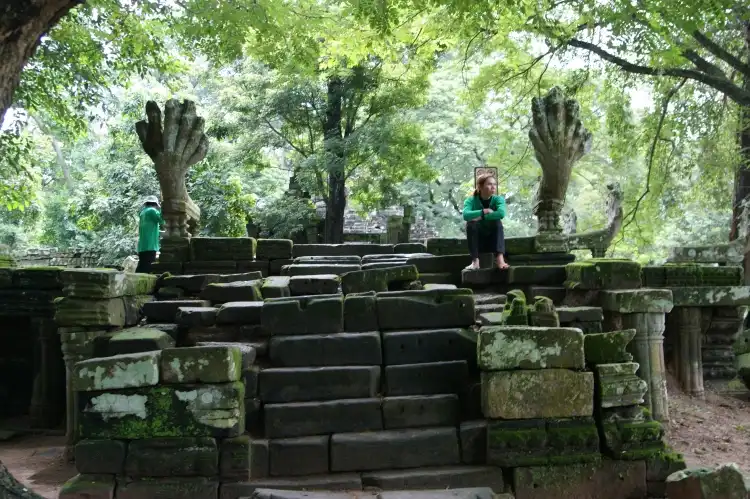
Architecture and Art
The temples display classic Khmer architectural styles. Intricate carvings depict Hindu mythology and everyday life. The serene atmosphere invites visitors to ponder ancient Cambodian culture.
Preah Pithu is a small temple, with a central tower surrounded by several smaller structures and galleries. The temple is famous for its elaborate carvings and sculptures. They depict scenes from Hindu mythology and depict mythical creatures, including demons, lions, and garudas.
The central tower of the temple is particularly noteworthy, as it features intricate carvings and sculptures on its exterior walls. The tower is surrounded by a moat, which was used to symbolize the ocean that separated the human world from the world of the gods in Hindu mythology.
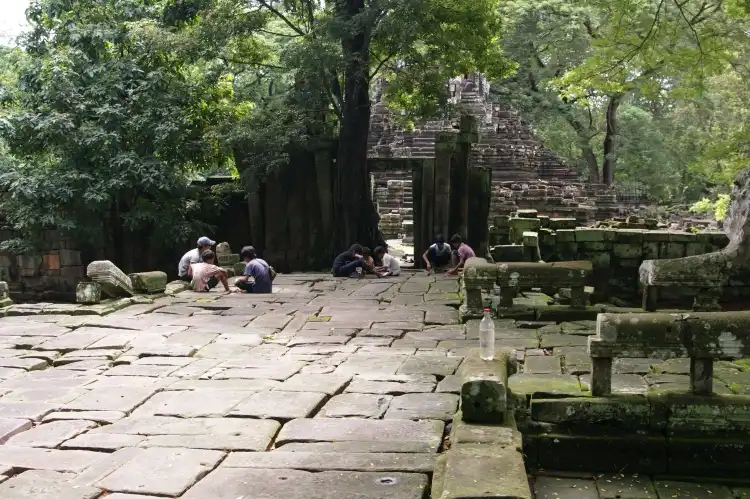
Visiting Preah Pithu
Located near the famous Bayon and Terrace of the Elephants, Preah Pithu is easily accessible. It’s best to visit this site early morning or late afternoon. This timing avoids the heat and crowds.
Why Visit Preah Pithu?
Preah Pithu offers a peaceful retreat from more crowded sites. Its tranquil environment and architectural beauty make it a must-see for history and architecture enthusiasts.
Tours
This temple is small in size and is not a destination for many tours. We recommend the Private Trekking Tour to The World Heritage Temples. This tour is a walking tour from Angkor Wat to Angkor Thom with a stop at Preah Pithu.
Tours visiting Angkor Thom pass near this temple.
The post Preah Pithu appeared first on Find Asia - Tours in Asia.
Neak Pean 27 Feb 2024, 4:57 am
A Unique Sanctuary in the Heart of Angkor, Cambodia
Introduction to Neak Pean
Neak Pean stands as a distinctive temple in the Angkor Archaeological Park, near Siem Reap, Cambodia. It dates back to the late 12th century, under King Jayavarman VII’s reign. This site is unique for its central island and surrounding water.
Symbolism and Design
Neak Pean symbolizes a mythical Himalayan lake. The name means “entwined serpents,” reflecting the naga sculptures that encircle the central pond. The temple represents the idea of healing waters. It was designed as a hospital, based on the belief in water’s curative properties.

Architectural Highlights
Neak Pean has a large square pond in the center with small square ponds attached to the four sides. The central platform has an unusual circular shape. A statue of the divine horse Varaha stands near the center of the pond.

However, since this is also not possible to approach, you can only see it to the extent that “that is so”. The left side of the photo below is the statue of the divine horse Varaha. And the central shrine of Nyak Pean is on the right side.
The central sanctuary sits on a small circular island. Causeway link it to surrounding pools. Each pool is connected to a different cardinal point. The layout reflects the Hindu-Buddhist cosmology, blending spiritual concepts with architectural innovation.
Visiting Neak Pean
Access to Neak Pean involves a walk through a wooden boardwalk. This path offers stunning views of the surrounding wetlands. The best time to visit is during or just after the rainy season. This is when the pools are full of water, enhancing the site’s beauty.

Conservation Efforts
Neak Pean has undergone various conservation projects to preserve its structures and significance. Efforts ensure the site remains intact for future generations.
Tours to Neak Pean
This temple belongs to the grand circuit. So you should find a tour that covers the grand circuit around Angkor Wat. Half-Day Preah Khan and Neak Pean Temples from Siem Reap tour may be the most convenient tour to visit this temple. As the tour name implies, this tour also visits Preah Khan.
The post Neak Pean appeared first on Find Asia - Tours in Asia.
Preah Khan 27 Feb 2024, 4:17 am
Discovering Preah Khan: A Gem of Angkor
Introduction to Preah Khan
Preah Khan, located in Siem Reap, Cambodia, stands as a monumental temple complex. It was built in the 12th century during the reign of King Jayavarman VII. Originally, it served as a Buddhist monastery and school. Today, it is a significant part of the Angkor Archaeological Park.
Historical Significance
Preah Khan translates to “Sacred Sword,” symbolizing the military victory of King Jayavarman VII. The site commemorates his win over invading forces. It also honors his father. The temple showcases the architectural genius of the Khmer Empire.
Architectural Wonders
The complex spans over 56 hectares. It features a unique mix of Buddhist and Hindu elements. Visitors marvel at its intricate carvings, towering gateways, and serene courtyards. The central sanctuary, surrounded by four rectangular enclosures, is a highlight.
One of the most interesting features of Preah Khan is the fact that it was designed to reflect the interconnectedness of all things. The temple’s many halls, courtyards, and passages are thought to symbolize the interconnectedness of the physical and spiritual realms, and the intricate carvings and sculptures depict scenes from Buddhist mythology and daily life in ancient Cambodia.
Exploring Preah Khan
Walking through Preah Khan, visitors experience a maze of halls, chambers, and shrines. The temple’s state of ruin adds to its charm. Nature intertwines with architecture, as trees grow over and through the stones.
A long approach, lined with lantern-like lingams on both sides, leads to the west pylon, where a bridge with a statue of Churning the Sea of Milk attracts naga.


When you pass through the west tower gate of Preah Khan, you will be surprised at the rather complicated structure inside. However, it is not possible to walk around all over because collapse and weathering are progressing. Basically, you will go straight on the line that connects the east and west gates to see it.
Reliefs and statues are scattered throughout the interior of Preah Khan. The picture below seems to be a battle scene in one of the gables, but what kind of scene is it?
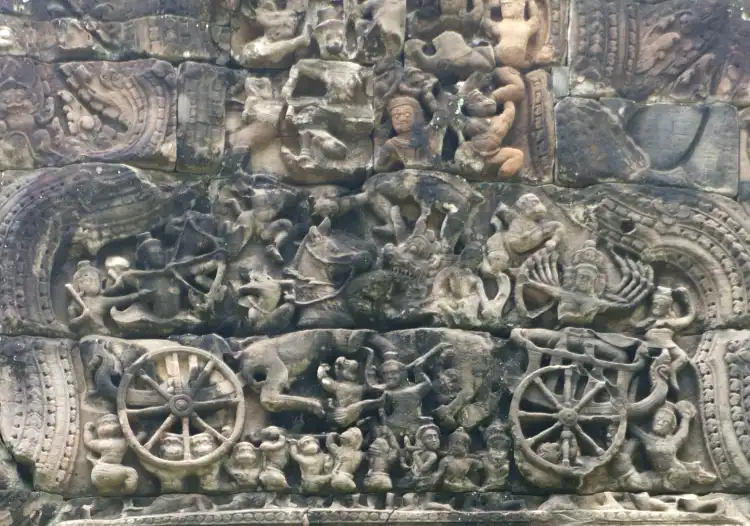
There are many small temples around the central shrine, and reliefs are embedded here and there.

Even more beautiful is the surrounding beams called Dancer’s Terrace. A group carved in the part of The picture below is one of them, said to be a dancing Apsara.

Another famous thing in Preah Khan is this two-story building. It is said that it was a library, but it seems that the purpose is not known.
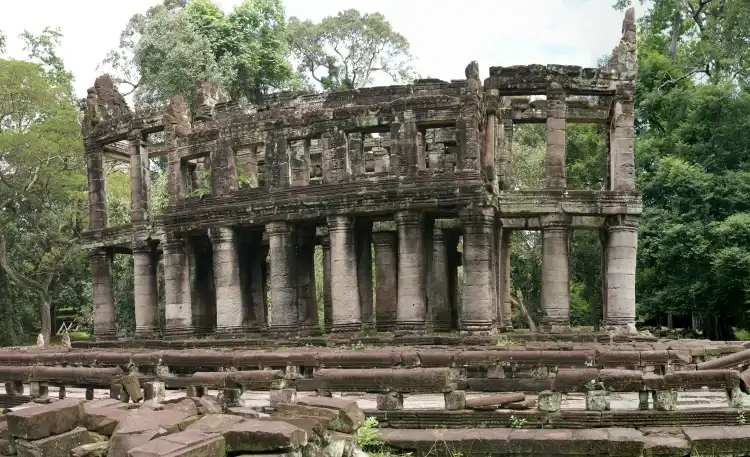
And when you look at the inner wall from the terrace with the Naga statue on the east side, you can see a very beautiful scenery.
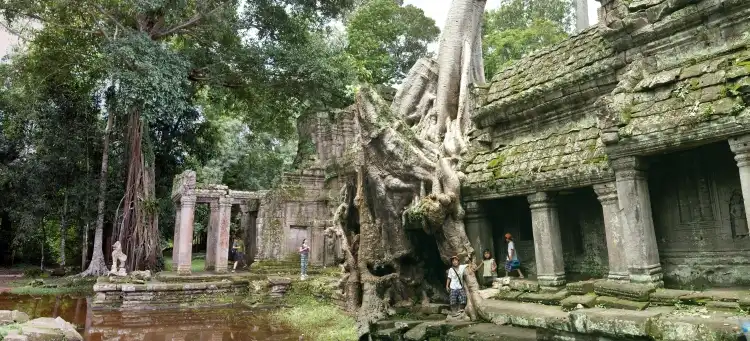
If you go outside from the outer wall to the east, you will find a large statue of Garuda embedded in the outer wall.
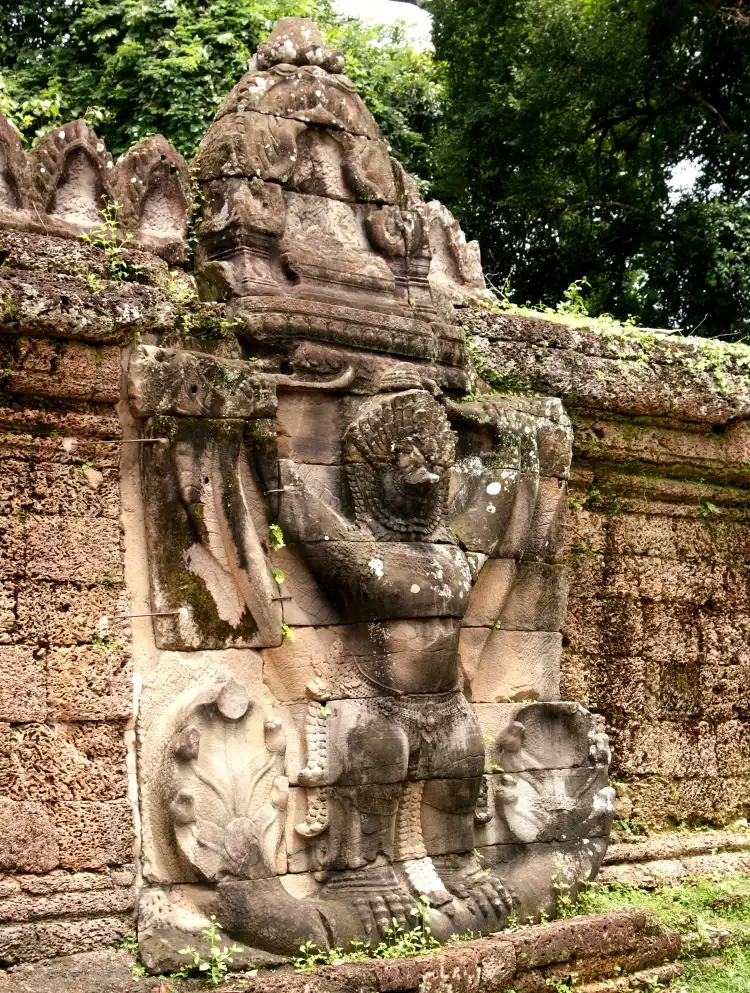
Access and Tips
Preah Khan is accessible from Siem Reap. A short drive or bike ride gets you there. Early morning visits are best. They offer cooler temperatures and fewer crowds. Respect the site’s cultural significance during your visit.
Tours
Some Angkor Wat tours also visit Preah Khan. This temple is one of grand circuit temples. So you should book a tour of the grand circuit. Half-Day Preah Khan and Neak Pean Temples from Siem Reap tour may be the most convenient tour to visit this temple. As the tour name implies, this tour also visits Neak Pean.
The post Preah Khan appeared first on Find Asia - Tours in Asia.
Banteay Kdei 26 Feb 2024, 6:06 am
Introduction to Banteay Kdei
Banteay Kdei, in the heart of Cambodia’s Angkor region, is a must-visit. This ancient Buddhist monastery dates back to the late 12th century. King Jayavarman VII built it. It’s less crowded than other Angkor temples. This makes it perfect for exploring in peace.
Historical Significance
Built as a Mahayana Buddhist monastery and university, Banteay Kdei means “A Citadel of Chambers”. It reflects the architectural style of the Bayon era. Its walls once housed monks, scholars, and artists. The site tells stories of Cambodia’s past.
What to See in Banteay Kdei
Banteay Kdei is known for its serene atmosphere and beautiful carvings. The temple’s entrances are guarded by giant smiling faces. Inside, intricate bas-reliefs and carvings depict Buddhist lore. The surrounding area, with its towering trees and overgrown ruins, adds to its charm.
The eastern pagoda has the same form as Bayon and has the four faces of Avalokiteshvara Bodhisattva.
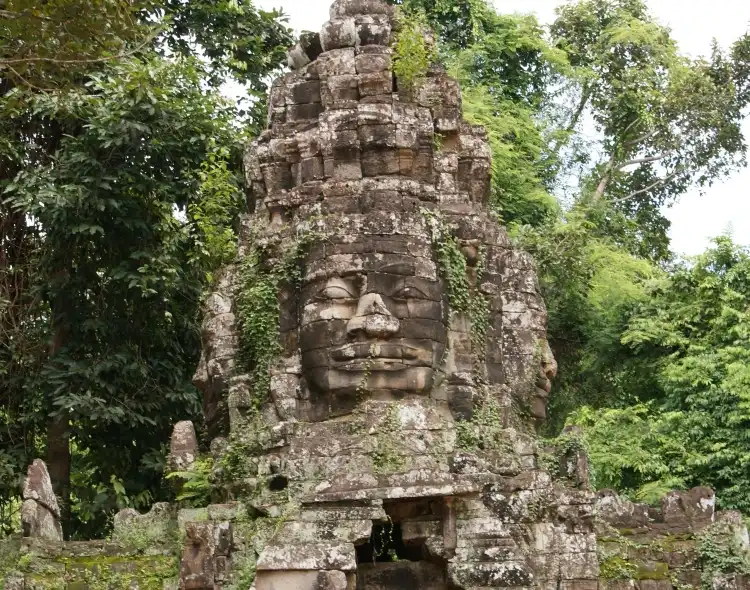
After passing through the pagoda, you will pass through an approach with Naga railings and a plaza called Dancer’s Terrace. After that, there is a pylon, leading to the center of Banteay Kudi. A part of the photo below is missing because it was composed by connecting multiple photos.

Inside Banteay Kudi, there are also beautiful statues such as Devata.

There is also a stone statue of Garuda at the west gate of Banteay Kudi.

Visitor Tips
- Best Time to Visit: Early morning or late afternoon for cooler temperatures and softer light for photos.
- Getting There: Located near Siem Reap, accessible by tuk-tuk or bike.
- What to Bring: Water, sunscreen, and a hat for protection from the sun.
Nearby Attractions
After exploring Banteay Kdei, visit nearby Ta Prohm and Angkor Wat. Both offer unique insights into Cambodia’s ancient civilization.
Tours
This temple is a part of the small circuit. So find the tours that visit the small circuit. Check them from here.
The post Banteay Kdei appeared first on Find Asia - Tours in Asia.
Bagan 21 Feb 2024, 6:25 am
Discovering Bagan, Myanmar: A Timeless Monument of Faith and Beauty
Bagan, in the heart of Myanmar, stands as a testament to the country’s deep Buddhist faith and architectural brilliance. Once the capital of the Pagan Empire, Bagan’s landscape is dotted with over 2,200 temples, stupas, and monasteries. It is one of the world’s greatest archaeological sites. Bagan is one of the three major buddhist sites in the world.
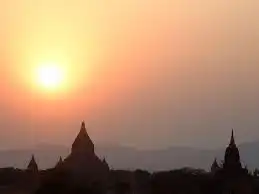
Historical Significance
Bagan’s construction peaked between the 11th and 13th centuries, under the rule of the Pagan Kingdom. This era saw the unification of regions that would later form modern Myanmar. The rulers and their subjects constructed more than 10,000 religious structures over this period, showcasing a fervent devotion to Buddhism.

Architectural Marvels
The temples of Bagan are famous for their diverse architectural styles, intricate carvings, and vibrant frescoes that depict Buddhist teachings and Jataka tales. Notable temples include Ananda Temple, with its glistening gold spires. And Dhammayangyi Temple, the largest of all Bagan temples, with its massive, pyramid-like structure.

Experiencing Bagan
Visitors to Bagan can explore the vast plains by bicycle, e-bike, or hot air balloon. It offers unparalleled views of the temples at sunrise or sunset. Each temple has its unique history and architectural details. They can give a glimpse into the spiritual and cultural life of ancient Bagan.
Cultural Legacy
Beyond its temples, Bagan is a living heritage site. Local artisans continue traditional crafts, including lacquerware, a Bagan specialty. The surrounding villages maintain a way of life. They have remained unchanged for centuries, offering insight into Myanmar’s rich cultural tapestry.

Preservation Efforts
Bagan’s inclusion in the UNESCO World Heritage list in 2019 marked a significant step toward its preservation. Efforts are now focused on sustainable tourism and the restoration of temples damaged by earthquakes and time. It ensures Bagan’s legacy endures for future generations.
Bagan is not just an archaeological site. It’s a journey back in time and a vibrant cultural experience. Its serene beauty and historical depth make it a must-visit destination for those seeking to understand Myanmar’s heart and soul.
Tours
All travelers to Myanmar should check the local political situation before leaving.
Several Bagan tours available such as One Bagan Sightseeing Tour. This tour starts from the airport in Bagan. So you should check the flight schedule.
The post Bagan appeared first on Find Asia - Tours in Asia.
Baphuon 21 Feb 2024, 5:58 am
Baphuon Temple: A Jewel of Angkor’s Heritage
Baphuon, a significant temple of the Angkor Wat complex, stands as a testament to Cambodia’s rich history. Located in the ancient city of Angkor, near Siem Reap, this temple predates Angkor Wat, marking an important era in Khmer architecture.
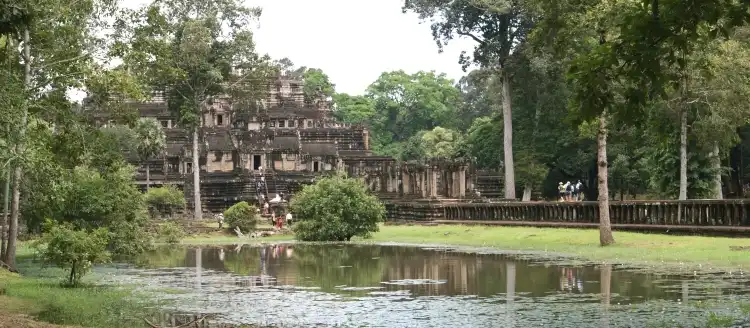
Historical Significance
Constructed in the 11th century under King Udayadityavarman II, Baphuon was dedicated to the Hindu god Shiva. It symbolizes the peak of Baphuon style architecture, characterized by its elaborate carvings and towering pyramidal structure. Originally, the temple served as the state temple of the capital, showcasing the religious and political power of the Khmer Empire.
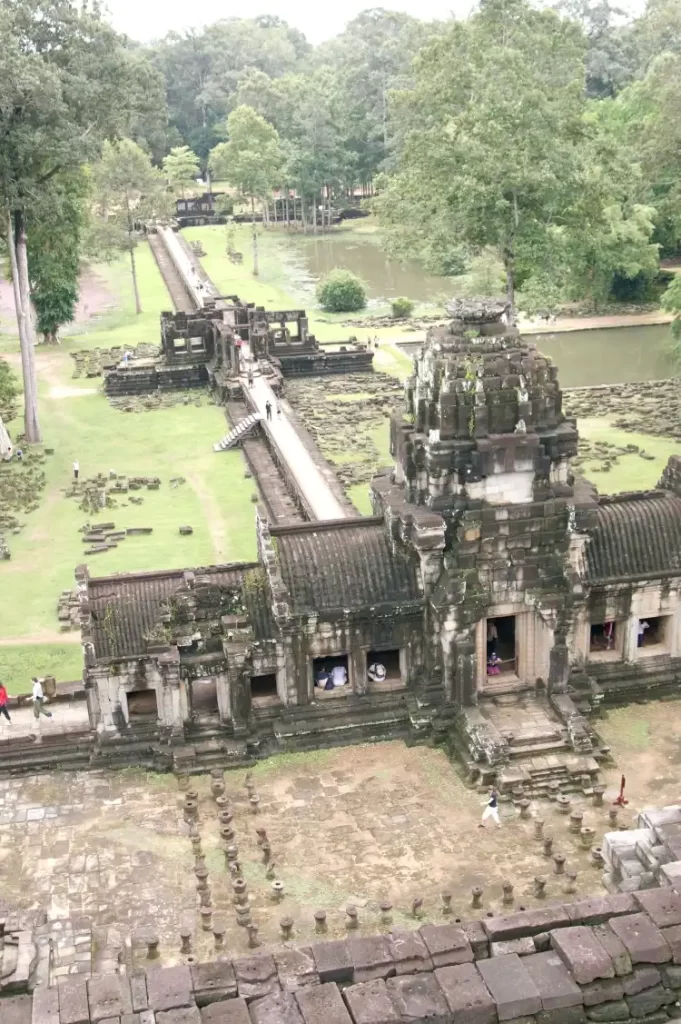
Architectural Marvel
Baphuon underwent a massive restoration process that lasted several decades, finally reopening to the public in 2011. This restoration highlighted its three-tiered temple mountain design, meant to represent Mount Meru, the center of the universe in Hindu and Buddhist cosmology. The temple features a long causeway leading up to its towering facade, adorned with intricate carvings that depict scenes from mythology and daily life in the Angkor period.
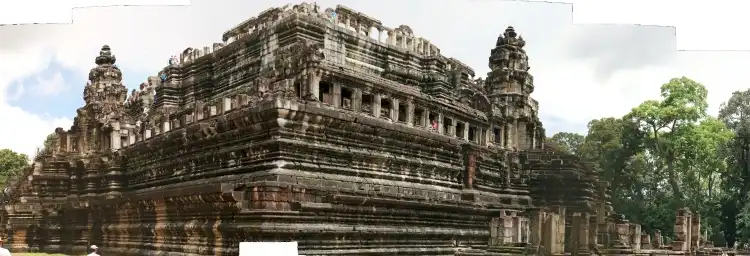
The Reclining Buddha
An interesting aspect of Baphuon is the addition of a large reclining Buddha on the west side, dating back to the 15th century when the temple was converted into a Buddhist temple. This addition is a significant representation of the religious transition from Hinduism to Buddhism in Cambodia’s history.
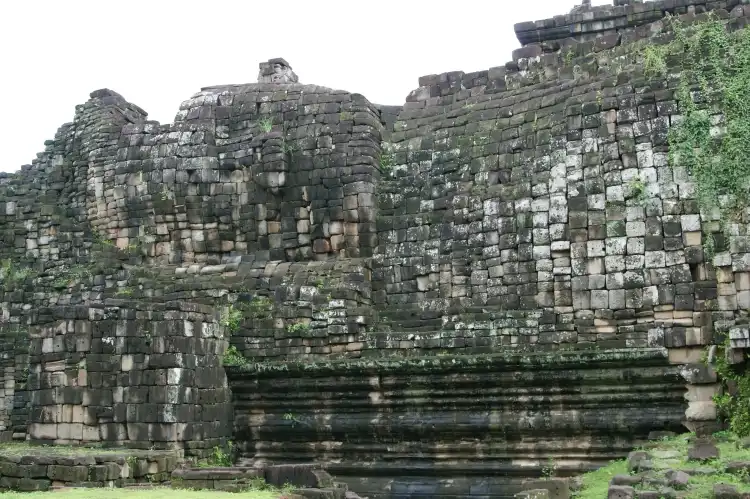
Visiting Baphuon
For travelers, Baphuon offers a unique glimpse into the grandeur of Angkor’s architectural prowess. It is less crowded than Angkor Wat, allowing for a more serene exploration. Visitors should note that the climb to the top offers breathtaking views but involves steep stairs. This is a common feature in ancient Khmer architecture. It intended to symbolize the difficulty of reaching the heavens.
Tours
Many Angkor Wat tours visit Baphuon. For a list of tours, please click here. Theis a list of temples in the details of each tour.
The post Baphuon appeared first on Find Asia - Tours in Asia.
Balinese Cooking Class in Ubud 20 Feb 2024, 6:56 am
For visitors to Bali, participating in a Balinese cooking class is a popular way to immerse in the local culture. These classes often include a visit to a traditional market to select fresh ingredients, followed by hands-on instruction in preparing Balinese dishes.

Ubud, the ancient capital and the heart fo Bali provides several Balinese Cooking classes for visitors.
Balinese Authentic Cooking Class in Ubud, for example, provides an opportunity to visit a traditional morning market, see a local Balinese house, tour a farm, then learn to make a variety of authentic Balinese dishes
The Essence of Balinese Cooking: A Culinary Journey
You can learn the essence of Balinese cooking in a class in Ubud.
Introduction to Balinese Cooking
Balinese cooking, a cornerstone of Indonesian cuisine, offers a flavorful journey through the island’s rich cultural heritage. It is famous for its vibrant spices, fresh ingredients, and unique cooking techniques. Balinese cuisine reflects the island’s diverse cultural influences and natural bounty.
Key Ingredients and Spices

At the heart of Balinese dishes are fresh, locally sourced ingredients. Coconut, lemongrass, galangal, and turmeric are staples, providing a base for the complex flavors characteristic of the cuisine. Balinese dishes often feature a blend of spices known as “bumbu Bali”. They include garlic, shallots, ginger, and chili peppers, creating a balance of sweet, savory, and spicy tastes.
Traditional Dishes
- Babi Guling (Suckling Pig): A festive dish, traditionally prepared for special occasions. The pig is stuffed with a blend of spices, then slow-roasted to perfection.
- Bebek Betutu (Slow-Cooked Duck): Marinated in a rich spice paste and wrapped in banana leaves, this dish is slow-cooked for hours, resulting in tender, flavorful meat.
- Lawar: A traditional mix of vegetables, coconut, and minced meat or fish, seasoned with rich spices and often served as a side dish.
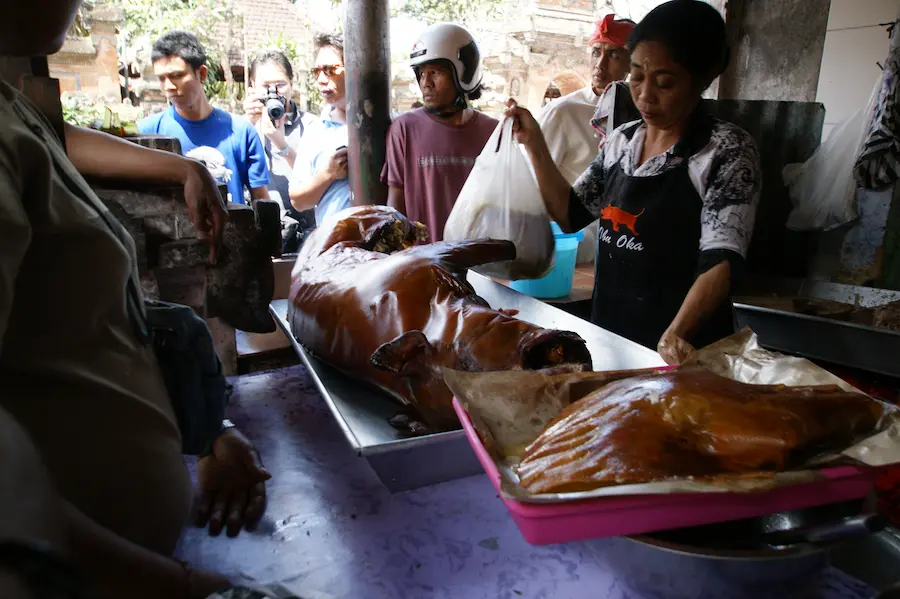
Cooking Techniques
Cooking techniques are as diverse as the cuisine itself. Grilling over coconut husks imparts a smoky flavor to meats and seafood. Slow cooking in banana leaves seals in moisture and flavor. On the other hand, steaming is for preparing delicate items like fish and vegetables.
Vegetarian Variations
The island’s Hindu culture has also influenced the development of a rich variety of vegetarian dishes. Tofu and tempeh, both soybean products, are common protein sources. Local people often prepare them with the same flavorful spices and techniques used in meat dishes.
The post Balinese Cooking Class in Ubud appeared first on Find Asia - Tours in Asia.
Pura Penataran Sasih 20 Feb 2024, 6:14 am

Pura Penataran Sasih, once considered the state temple of the Pejeng Kingdom, stands in Bali as a beacon of historical and cultural significance. Located in the village of Pejeng, near Ubud, this temple is renowned for housing the largest single-cast bronze kettle drum in the world, known as the “Moon of Pejeng.” Dating back to over a thousand years, Pura Penataran Sasih offers a glimpse into Bali’s rich past.
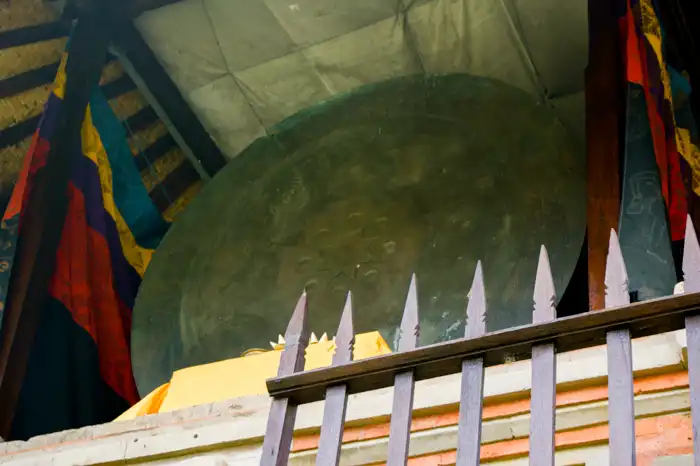
Historical Background of Pura Penataran Sasih
The “Moon of Pejeng” is an artifact of great mystery and significance. It dates back to 300 BC and has been a relic of early Balinese culture before Hinduism took root on the island. The drum, which is representing the moon, holds a pivotal place in Balinese mythology. Legend has it that the moon fell from the sky and landed in Pejeng, and the drum is a manifestation of that celestial event.
Architectural Features
This temple’s buildings showcase classic Balinese architecture with its intricately carved gates and stone guardians that protect the sacred grounds. The temple complex is a serene space, offering a peaceful atmosphere for reflection and worship. The centerpiece, the “Moon of Pejeng,” is in a special pavilion. And it continues to be an object of reverence and fascination.
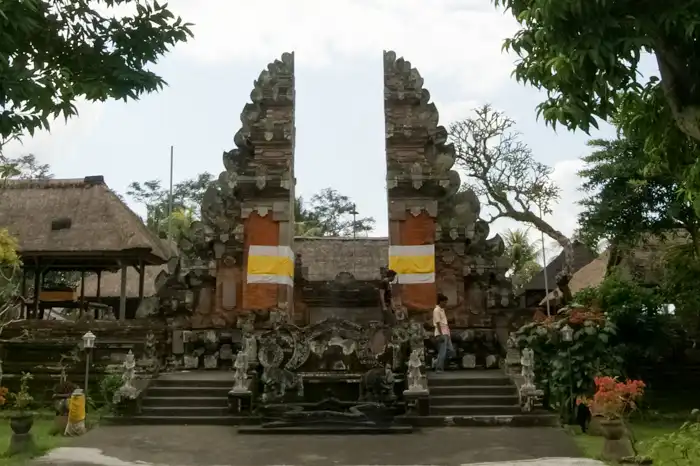
Cultural and Religious Significance
The temple serves as a significant spiritual center for the local community. It plays a key role in the religious life of the people, hosting ceremonies and festivals that follow the Balinese Hindu calendar. These events are a vibrant showcase of Balinese culture, featuring traditional music, dance, and offerings to the gods.

Visiting Pura Penataran Sasih
For those interested in history, culture, and spirituality, should visit the Pura Penataran Sasih. The best time to visit is during one of the temple’s many festivals, offering an immersive experience into Balinese culture. However, visitors have to dress respectfully and follow the temple’s guidelines to maintain the sanctity of this sacred site.
Tours
Not many tours include the visit to Pura Penataran Sasih. So you may take a Tok Tok from Ubud to visit there. 2-Day Private Rural and Beach Bali Tour with Pick Up visits the temple on the first day of the tour.
The post Pura Penataran Sasih appeared first on Find Asia - Tours in Asia.
Goa Gajah 20 Feb 2024, 5:29 am
Goa Gajah stands as a testament to Bali’s rich cultural and spiritual heritage. Its mysterious cave, ancient carvings, and tranquil gardens offer a unique journey into the past. This historic site is a must-visit for those looking to explore Bali’s historical depth and spiritual essence.
Discovering Goa Gajah: Bali’s Mystical Elephant Cave
Introduction
Goa Gajah, or the Elephant Cave, is a significant historical site in Bali, Indonesia. This ancient sanctuary mesmerizes visitors with its rich history, intriguing architecture, and spiritual ambiance. Located near Ubud, Goa Gajah dates back to the 9th century. It serves as a window to Bali’s fascinating past.
Goa Gajah is a ruins, but like other Bali ruins, it is still treated as a temple and holy place, and it is necessary to pay attention to clothing, such as not putting out shin when entering Goa Gajah. If you visit with shorts or short skirts, you will be instructed to wrap your waist at the entrance and lend you the cloth.
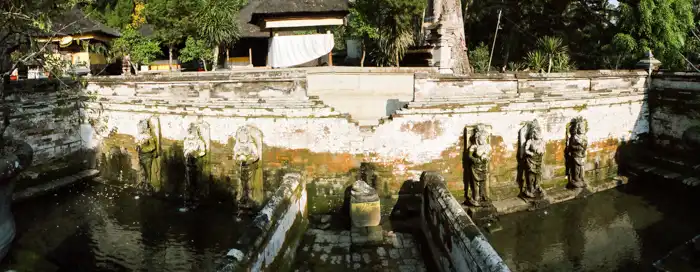
Goa Gajah is famous as the “Elephant Cave”. But attractions are not only the cave. Pay attention to the surroundings and you will gain even more insight.

Historical Significance
The real origins of Goa Gajah are in mystery. People have used it as a spiritual place for meditation. The site’s name, “Elephant Cave,” does not come from elephants found in Bali. Instead, it is believed to be linked to the Hindu god Ganesh, known for his elephant head. The cave’s entrance, a menacing mouth of a demon, is a masterpiece of Balinese sculpture, designed to protect the sacred site from evil spirits.
Exploring Goa Gajah
The screaming mouth of the entrance to the cave greet you. It leads into a dark, narrow passage. Inside, the cave has several areas. They are meditation spaces and a place for prayer. The central figure is a statue of Ganesh, adding to the cave’s mystical atmosphere.
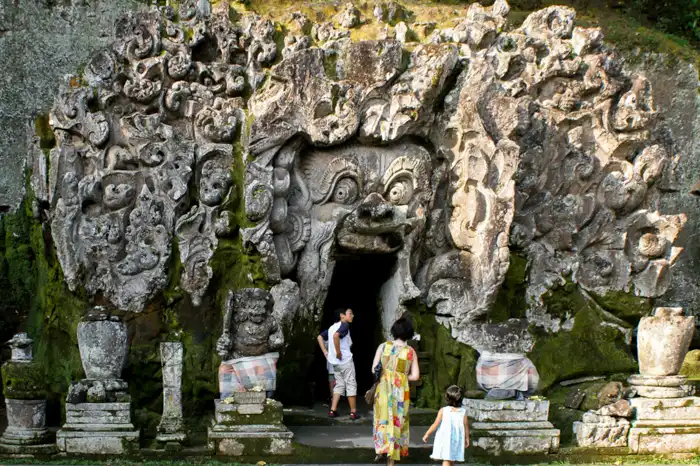
Surrounding the cave, lush gardens, and ancient relics, including bathing pools and fountains, invite exploration. These water features with stone carvings of women might have been the place for ritual purification.


Cultural and Spiritual Experience
This place is not just an archaeological site; it is a spiritual destination. The serene atmosphere and sacred artifacts offer a unique insight into Balinese Hinduism and its practices. Visitors can absorb the spiritual energy and reflect on the ancient rituals that have taken place here.

Access and Best Time to Visit
Located just outside of Ubud, it is easily accessible by car or motorbike. The best time to visit is early in the morning or late in the afternoon to avoid the crowds and experience the site’s tranquility. The rainy season, from November to March, brings lush greenery, enhancing the beauty of the surrounding landscape.
Goa Gajah Tours
Several tours that includes places around Ubud visit the Elephant Cave. One of those is Best of Ubud Attractions: Private All-Inclusive Tour. You can join this tour from Ubud, Denpasar and Kuta. Please check the starting points before you choose a tour.
The post Goa Gajah appeared first on Find Asia - Tours in Asia.
Ta Som 20 Feb 2024, 3:42 am
Ta Som, with its historical significance and natural beauty, is a must-visit for those exploring Cambodia’s Angkor region. It offers a peaceful retreat from the more crowded sites, allowing visitors to immerse themselves in the mystique of ancient Khmer civilization.
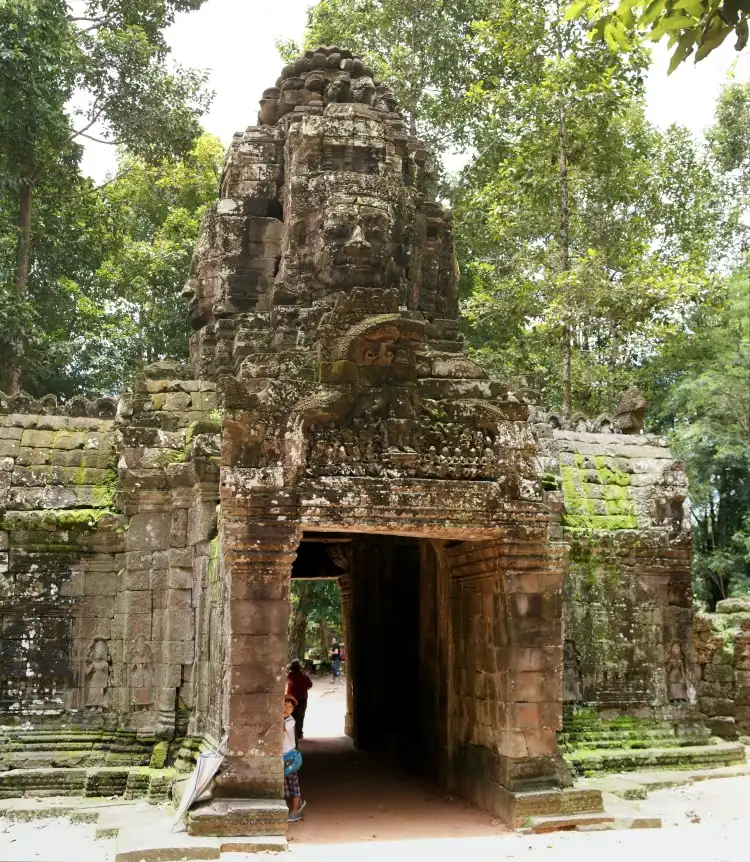
Discover the Hidden Gem of Cambodia: Ta Som
Introduction to Ta Som
Ta Som is a small yet fascinating temple located in the Angkor Archaeological Park, Cambodia. Built in the late 12th century by King Jayavarman VII, it stands as a testament to the Khmer Empire’s grandeur. Unlike the more famous Angkor Wat and Bayon, this temple offers a quieter, more intimate glimpse into ancient Cambodia.
Historical Significance
This temple was dedicated to the king’s father, Dharanindravarman II. It is part of Jayavarman VII’s extensive building program, which also included hospitals, rest houses, and other temples. Ta Som’s unique feature is its eastern gopura (gateway) with the face of Avalokiteshvara. It symbolizes the king’s deep Buddhist faith.
Exploring Ta Som
a Som’s compact size allows for a detailed exploration of its intricate carvings and architecture. The central sanctuary, surrounded by enclosures and moats, showcases classic Khmer artistry.
After passing through the tower gate, there is an inner wall and the west gate. Beyond the gate, you can see a small shrine. As you can see, the building is not in a very good state of preservation.

However, you can see that there are many devata (goddess) reliefs.

One of the most distinctive features of Ta Som is the large tree growing out of the central tower. It adds to the temple’s unique beauty. The temple is surrounded by a moat and is accessible by a causeway. The temple is considered to be a well-preserved example of Angkor-style architecture. So it is a popular destination for tourists visiting the Angkor region.
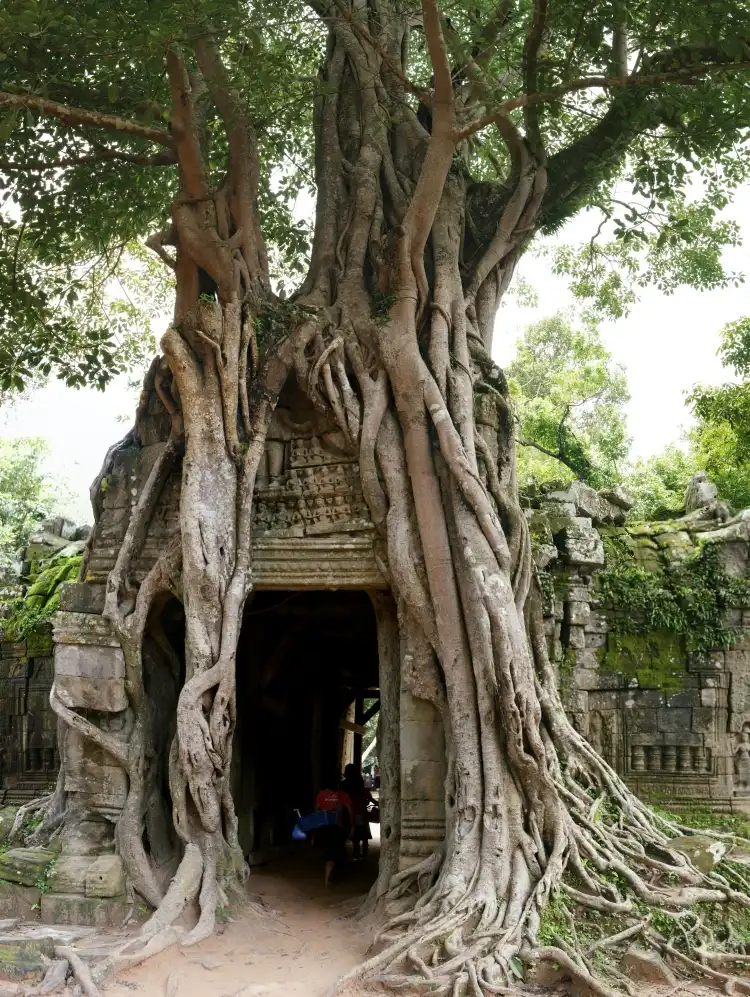
Events and Best Time to Visit
The best time to visit this place is between November and February when the weather is cooler and dry. The temple is also a quiet spot to witness the Angkor Archaeological Park’s seasonal changes.
Access and Tips for Visitors
Ta Som is part of the larger temple complex of Angkor Wat. Tourists often visit there in conjunction with other temples in the area.
Ta Som is accessible by tuk-tuk or bike from Siem Reap, the gateway to Angkor’s temples. Visiting early in the morning or late in the afternoon is good to avoid the crowds. It is also the best time to experience the temple’s tranquil beauty in softer light.
Tours
You can visit Ta Som temple if you choose a tour that includes the grand circuit. Here is the full list.
The post Ta Som appeared first on Find Asia - Tours in Asia.
Lolei 19 Feb 2024, 5:46 am
Lolei may be the smallest temple within the Roluos Group, but its historical depth and tranquil charm offer a profound experience. It serves as a poignant reminder of Cambodia’s rich cultural heritage and the enduring spirit of its people.
Lolei: The Last Jewel of the Roluos Group in Cambodia
Lolei stands as the northernmost temple of the Roluos Group, a collection of early Angkor-era monuments. Located just a short distance from Siem Reap, this temple offers a unique insight into the architectural and spiritual beginnings of the Khmer Empire. Built in the late 9th century by King Indravarman I, Lolei originally served as an island temple within the now-dry Indratataka baray (reservoir). It symbolizes the Hindu mythological ocean of milk.
Historical Significance and Architecture
Dedicated to Shiva and to honor the king’s ancestors, Lolei is noted for its four brick towers on a single laterite platform. Despite the ravages of time and elements, the temple’s intricate carvings and inscriptions provide a fascinating glimpse into the past. These inscriptions are among the oldest in Khmer history, offering critical insights into the social, religious, and political life of the time.
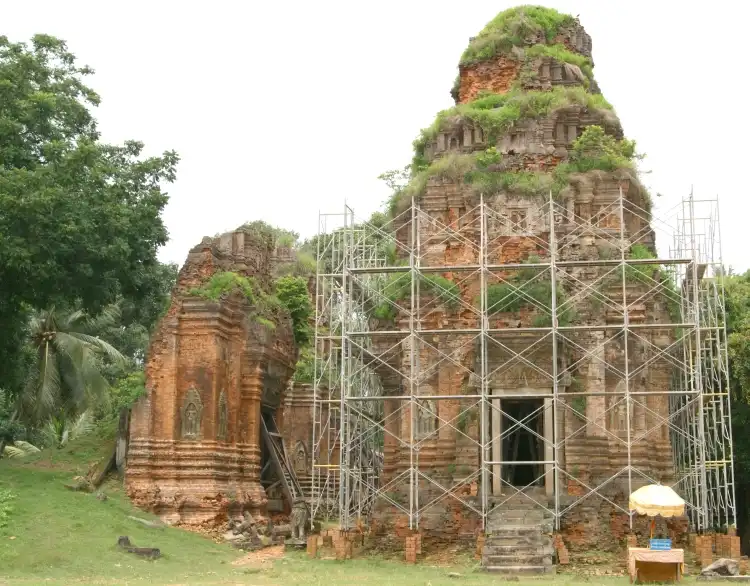
Exploring Lolei’s Charms
Although smaller and less preserved than its Roluos counterparts, Bakong and Preah Ko, Lolei’s serene atmosphere and fewer crowds make it a rewarding visit. The detailed lintels and false doors exhibit classic examples of early Khmer art, including depictions of Indra, the Hindu god of rain, riding his three-headed elephant, Airavata.
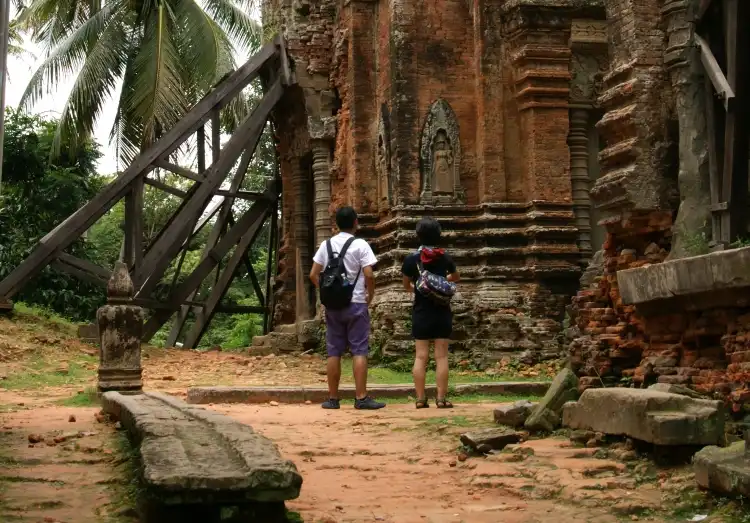
Cultural and Religious Layers
Lolei’s religious significance extends beyond its Hindu origins. Over the centuries, the site has also embraced Buddhist traditions, reflecting the syncretic nature of Cambodian spirituality. Visitors can see Buddhist elements added over time, contributing to the temple’s layered cultural tapestry.
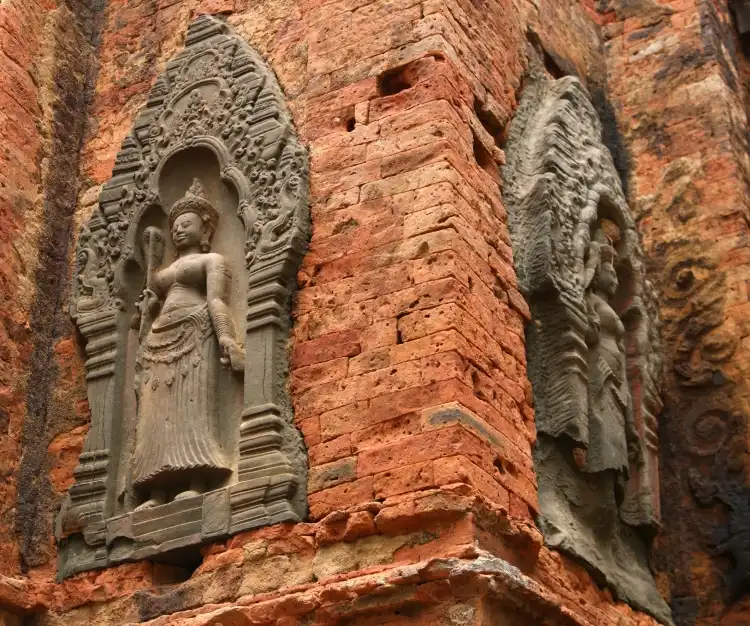
Best Time to Visit
The ideal time to visit Lolei is during the cooler, dry season from November to February. Morning visits are particularly recommended, allowing travelers to enjoy the site in the soft early light and cooler temperatures.
How to Get There
Lolei is easily accessible from Siem Reap, making it an ideal destination for a day trip exploring the Roluos Group. The journey offers picturesque views of the Cambodian countryside, including rice paddies and local villages.
Lolei Tours
There are several Angkor tours that visit this temple. Find a tour that visit Roluos Group. Roluos group include temples such as Bakong and Preah Ko.
The post Lolei appeared first on Find Asia - Tours in Asia.
Preah Ko 19 Feb 2024, 5:25 am
Preah Ko serves as a fascinating introduction to the early Angkor period. It offers visitors a glimpse into the foundational aspects of Khmer architecture and religious practices. Its historical depth and artistic beauty make it a compelling stop for those seeking the roots of Cambodian culture.
Preah Ko: The Sacred Bull Temple of Ancient Cambodia
Preah Ko, translating to “The Sacred Bull,” Nandi, is an integral part of Cambodia’s rich historical tapestry. It situates in the Roluos group near Siem Reap. Preah Ko is one of the earliest temples in the ancient city of Hariharalaya. It marks the beginnings of Khmer classical art and architecture in the late 9th century.
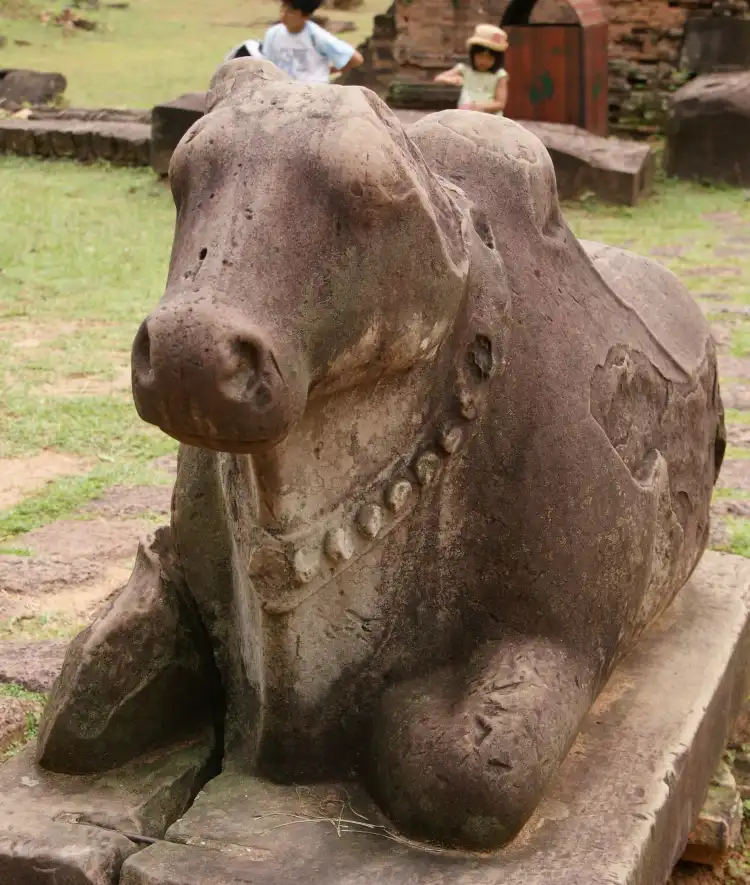
Historical Significance of Preah Ko
In 879 AD, Preah Ko was constructed to honor the king’s ancestors. It symbolizes a profound connection between divine worship and royal lineage. The temple is notable for its six brick towers in two rows. Each of them is dedicated to a specific ancestor of the king and connected to Hindu mythology.
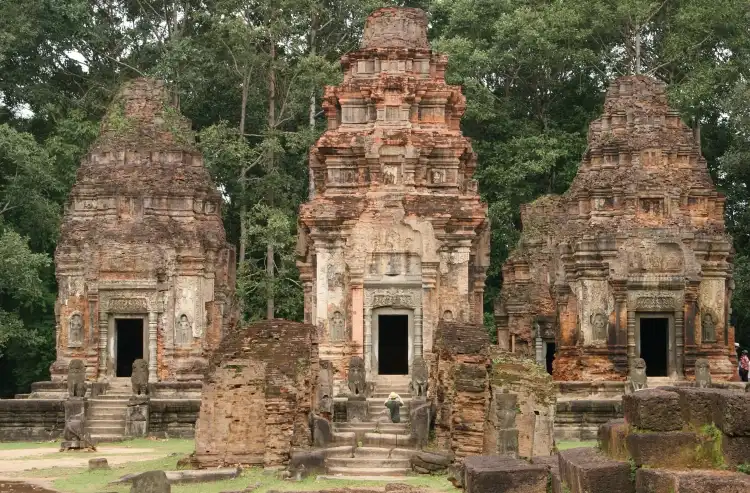
Architectural Marvels of Preah Ko
Preah Ko’s architecture is a marvel. It is showcasing early examples of the intricate carvings and detailed lintels that would define Khmer temple construction. The sandstone carvings depict Hindu deities and mythological scenes, offering insights into the spiritual and artistic culture of the time.
Exploring the Temple Complex
Three pairs of towers with exquisite carvings and inscriptions greet the visitors. The front row is dedicated to the king’s male ancestors, while the back row honors their wives. The temple’s central feature, the stone statues of Nandi, Shiva’s sacred bull, gives Preah Ko its name. It also indicates the temple’s Hindu origins.

Inscription at Preah Kor. It seems that the ancient Khmer language used Sanskrit words.
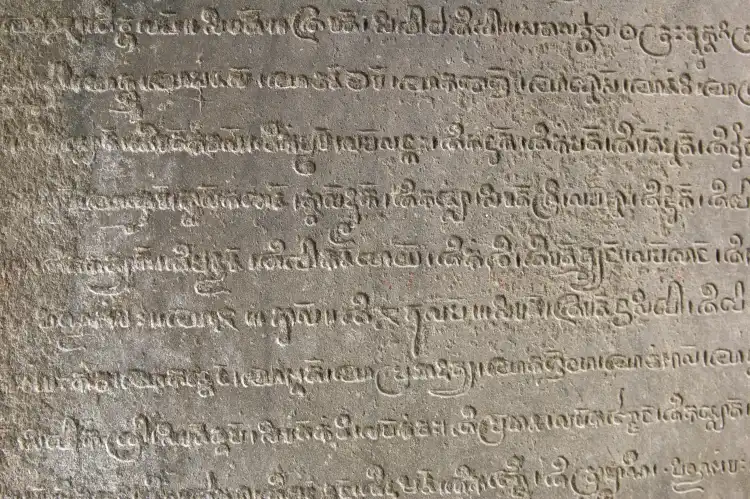
Best Time to Visit
The ideal times to visit Preah Ko are early in the morning or late in the afternoon to avoid the heat of the day. The cooler months from November to February offer the most comfortable climate for exploration.
How to Get There
Preah Ko is accessible from Siem Reap, located just a short distance from the main group of Roluos temples. Visitors can hire a tuk-tuk, bicycle, or join a guided tour to explore this historical site, often combined with visits to Bakong and Lolei for a comprehensive look at the Roluos group.
Tours
There are several Angkor tours that visit this temple. Find a tour that visit Roluos Group. Roluos group include temples such as Bakong and Lorei.
The post Preah Ko appeared first on Find Asia - Tours in Asia.
Bakong 19 Feb 2024, 4:24 am
Bakong: The Cornerstone of Angkor’s Majestic History
Bakong stands as a monumental testament to the early Angkor period, marking a significant chapter in Cambodian history. Located in the Roluos group, about 15 kilometers southeast of Siem Reap, this temple predates the famous Angkor Wat. It offers visitors a glimpse into the dawn of Khmer architectural brilliance.
Unveiling the History of Bakong
King Indravarman I constructed this temple in the late 9th. At that era, Bakong served as the state temple of the first Khmer capital, Hariharalaya. It is revered as the first temple mountain, symbolizing Mount Meru, the center of the universe in Hindu and Buddhist cosmology. This pioneering structure laid the groundwork for future temple mountains in the region.
Architectural Splendor of Bakong
When you enter the premises of Bakong Temple from the east side, you will be greeted by a Naga statue at the bridge that crosses the moat. Although it is not in good condition, it is a large naga with a very stately appearance.

Bakong’s grandeur lies in its five-tiered pyramid structure. Moat remnants are surrounding the temple. They evoke an image of a sacred mountain emerging from the ocean. In addition, the temple complex has intricate carvings, lintels, and statues that narrate tales of Hindu mythology, primarily dedicated to Shiva.

Exploring the Sacred Grounds
Visitors are greeted by a causeway leading to the central sanctuary, flanked by Naga balustrades and guardian lions. From there, the ascent to the summit offers panoramic views of the surrounding countryside and a closer look at the sanctuary’s detailed carvings. The presence of Buddha statues in the temple also reflects the syncretism of Hindu and Buddhist beliefs in ancient Cambodia.
One of the few reliefs in good condition remains at the base of the fifth layer, the Ashura relief. Other than this, only a faint relief remains. And most of the reliefs that once surrounded the fifth layer were already gone.

Below is the view from the top of Bakong Temple. Comparing to other temple ruins, there are few reliefs here. However, it seems that many of them have already been weathered. There are statues such as elephants, so please look for them.
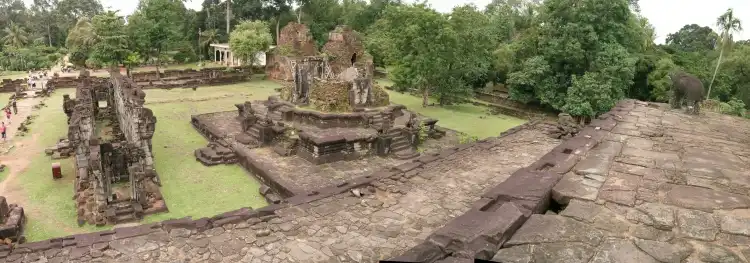
Best Time to Visit
The best time to visit Bakong is during the cooler months from November to February. To experience the temple in the best light, you’d better visit there in early morning or late afternoon. It also avoids the midday heat.
How to Get There
Bakong is easily accessible from Siem Reap. It is a convenient day trip for those exploring the Angkor region. Local tuk-tuks, bicycles, and guided tours offer various ways to reach the temple.
Tours
There are several Angkor tours that visit Bakong. Find a tour that visit Roluos Group.
The post Bakong appeared first on Find Asia - Tours in Asia.
Prasat Kravan 19 Feb 2024, 3:14 am
Prasat Kravan: A Hidden Gem in the Heart of Angkor
Located within the sprawling Angkor Archaeological Park, Prasat Kravan stands as a unique testament to the architectural ingenuity of the Khmer Empire. Built in the 10th century under the reign of King Harshavarman I, this lesser-known temple offers a serene escape from the more crowded sites of Angkor.
The Significance of Prasat Kravan
Prasat Kravan, dedicated to the Hindu god Vishnu, is notable for its distinct brick construction and bas-relief carvings.

Unlike many other temples in the region, Prasat Kravan was likely constructed by high-ranking officials rather than a king, showcasing a different aspect of Angkorian society.
Exploring the Architectural Marvel
The temple features five towers, aligned north to south, each containing unique bas-reliefs carved directly into the brick – a technique rare in Angkorian architecture. These carvings depict Vishnu and his consort, Lakshmi, offering insight into the religious practices and artistic styles of the time.
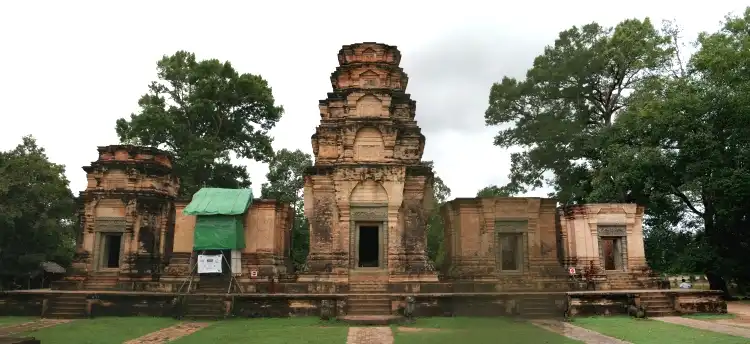
The Bas-Reliefs of Prasat Kravan
The central tower houses the most impressive bas-reliefs, including a depiction of Vishnu standing on the mythical serpent Ananta. This imagery is not only a masterpiece of Khmer art. But it is also a symbol of the god’s power and eternal nature.
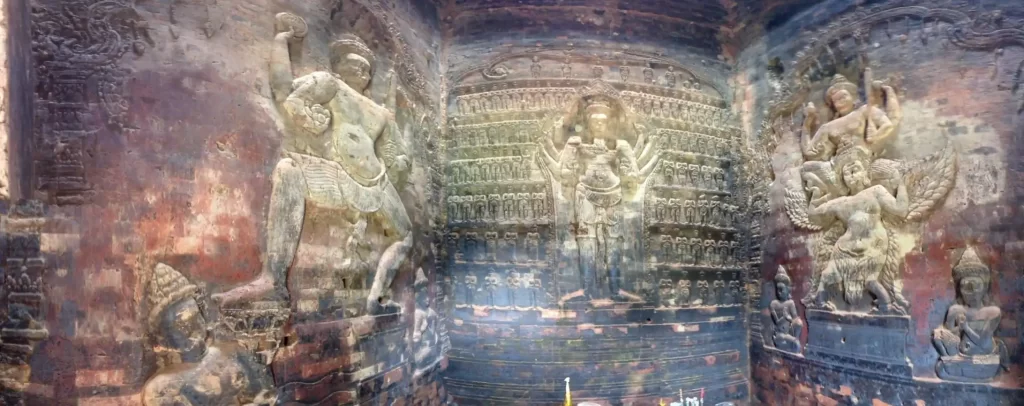
To fully capture this beautiful image, you should have a 360-degree camera.
How to Get There
Prasat Kravan is easily accessible from Siem Reap, located just a few kilometers south of the main Angkor Wat complex. Visitors can reach the temple by bike, tuk-tuk, or as part of a guided tour. It is a convenient addition to any Angkor itinerary.
Best Time to Visit
To fully appreciate the quiet beauty of this temple, visiting during the early morning or late afternoon is the best. These times offer softer light for photography and a more peaceful atmosphere.
Tours
Although there are no tours that visit only Prasat Kravan, many Angkor Wat tours include a visit to this temple. The tours named “small circuit” are particularly good to visit this temple. Please click here to see a full list of tours that visit Prasat Kravan.
The post Prasat Kravan appeared first on Find Asia - Tours in Asia.
Kbal Spean 19 Feb 2024, 2:10 am
Kbal Spean offers a unique combination of nature, history, and spirituality. It’s a testament to Cambodia’s rich cultural heritage. This site invites travelers to explore the mysteries of the ancient Khmer Empire, nestled in the tranquility of the Cambodian jungle.
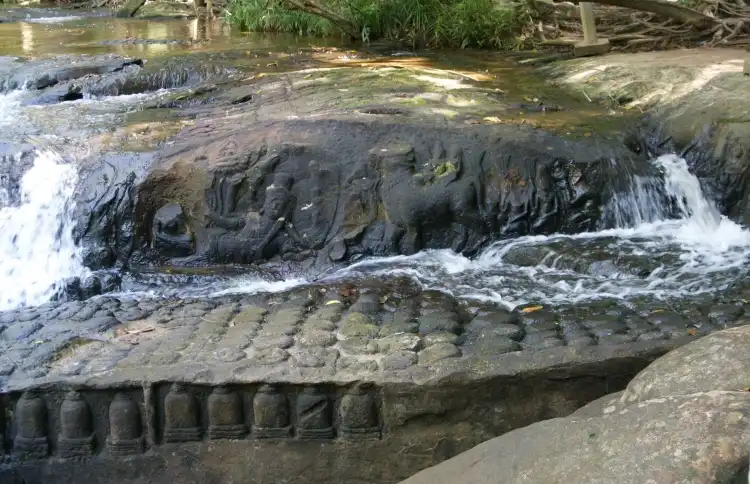
Cambodia’s River of a Thousand Lingas
Kbal Spean, also known as the “River of a Thousand Lingas,” is a sacred site located in Cambodia’s Siem Reap Province. It is a series of carvings and sculptures located in a lush, forested area near the Kulen Mountains.
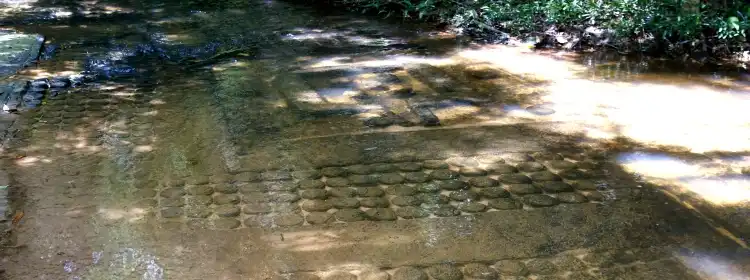
The site features numerous carvings of Hindu deities and symbols, including lingas (phallic symbols that represent the Hindu deity Shiva), as well as images of Hindu gods and goddesses. The carvings were created by Hindu devotees in the 11th and 12th centuries and are believed to have been used for religious rituals and offerings.
The carvings are located along a rocky riverbed and are surrounded by lush vegetation. It makes a peaceful and serene setting. Visitors to Kbal Spean can hike to the site and admire the intricate carvings and sculptures. They are really some of the finest examples of Angkorian art and architecture.
Discover the Sacred Waters of Kbal Spean
Located in the heart of Cambodia’s lush jungle, this is a unique archaeological site. Known as the “River of a Thousand Lingas,” it offers a blend of nature and ancient spirituality. This site lies within the Phnom Kulen National Park, about 50 kilometers from the famous Angkor Wat.
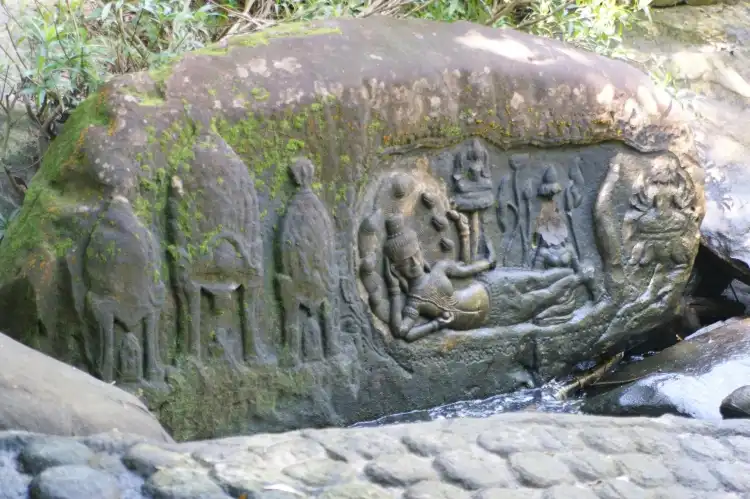
A Journey Back in Time
This place dates back to the 11th century during the reign of the Khmer Empire. The site is famous for its riverbed and banks adorned with Hindu symbols. These include lingas (phallic symbols of Lord Shiva), Yoni, and images of Hindu deities.
The Trek to Sacred Waters of Kbal Spean
Visitors embark on a moderate 1.5-kilometer trek through the jungle to reach Kbal Spean. The path leads to the river, where the ancient carvings reveal themselves. The trek is an opportunity to experience Cambodia’s natural beauty up close.
Some of the carvings are in difficult to find locations. It is strongly recommended that you join a guided tour or, if not, find a local guide.
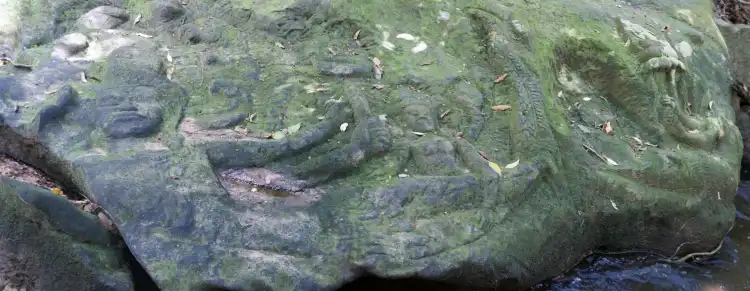
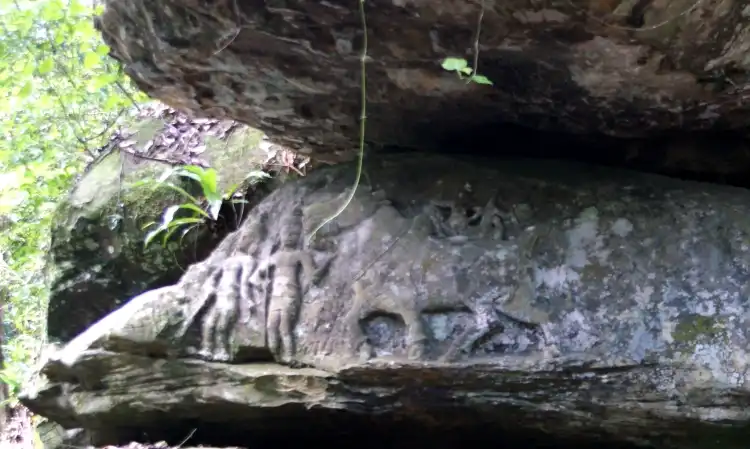
Witnessing Nature and Spirituality
The river’s water flows over the sacred carvings, believed to bless it. This makes Kbal Spean not just a historical site but a living spiritual journey. The best time to visit is during the wet season, from May to October, when the river is full.
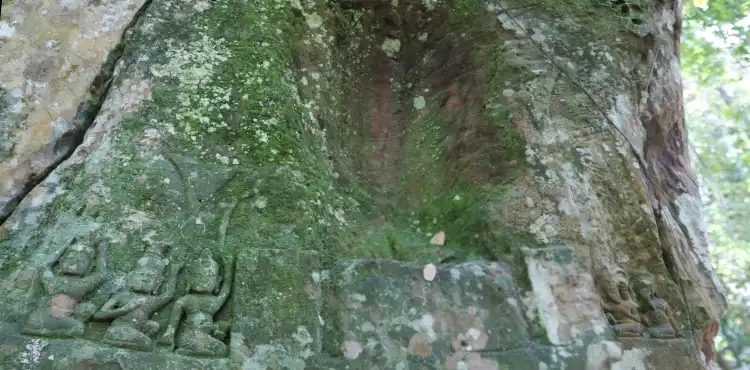
Nearby Attractions
After exploring Kbal Spean, visitors can visit other nearby wonders. The Banteay Srei temple, known for its intricate carvings, is just a short drive away. The Phnom Kulen waterfall also offers a refreshing break.
Accessing Kbal Spean
From Siem Reap, visitors can take a car or join a tour to reach Kbal Spean. It’s about a 2-hour drive, making it a perfect day trip destination.
Tours
There are many tours available from Siem Reap. Most of them also visit Banteay Srei temple to make it a one-day tour. For example, Kbal Spean, Banteay Srei & Banteay Samre temple is a good one day tour.
The post Kbal Spean appeared first on Find Asia - Tours in Asia.
Banteay Srei 19 Feb 2024, 2:08 am
Banteay Srei is more than a temple; it’s a journey back in time. Its artistry and architecture offer a window into the soul of ancient Cambodia. A visit here complements the Angkor Wat experience, providing a deeper understanding of Khmer culture and history.
Discover the Enchanting Banteay Srei: A Citadel of Women
The temple’s name, “Banteay Srei,” translates to “Citadel of the Women.” And women might have built the temple due to the intricate and delicate nature of its carvings.
The temple is famous for its beautiful carvings and reliefs. They cover almost every surface of the temple and depict scenes from Hindu mythology, including stories from the Ramayana and the Mahabharata. The carvings are notable for their intricate detail and their use of red sandstone, which gives them a distinctive pinkish hue.
Today, Prasat Banteay Srei is a popular tourist destination and a UNESCO World Heritage Site. It is one of the must-see temples in Cambodia, and attracts visitors from around the world who come to admire its beauty and learn about its history and cultural heritage.

Especially famous is the statue of Devata (goddess), the Oriental Mona Lisa. There is also an episode that André Malraux was fascinated by the statue and stole it in 1923 and was arrested.
A Glimpse into History and Architecture
Banteay Srei was dedicated to the Hindu god Shiva in the year 967. Unlike other Angkor temples, it was not built by a king but by a Brahmin priest. This temple is renowned for its delicate beauty, often thought to be the work of women. Its carvings are among the finest, most detailed in Cambodia, depicting scenes from Hindu mythology.
Prasat Banteay Srei has surrounding perimeter wall and has an entrance on the east side. Passing through the gate is the approach, and the approach is lined with lingams. In the photo below, the water on both sides of the approach is not a pond, but a puddle formed during the rainy season. In the back of the approach, you can’t see the intimidating towering temples like Bayon or Angkor Wat.
Exploring the Temple
Follow the approach to Prasat Banteay Srei, pass through the pylon of the first wall, and you will find a moat, and a bridge filled with earth will lead to the second wall and its pylon. As you can see, the center of Prasat Banteay Srei is very compact. However, there is an amazing sculpture hidden inside.
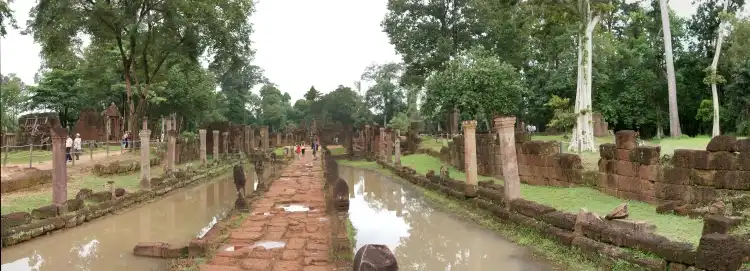
The compact size of the temple complex allows for an intimate exploration. Each structure within the site tells a story from the Ramayana and other epics, inviting guests to ponder the skilled artisans of the past. The temple’s pinkish hue at dawn and dusk adds to its enchanting appeal.
After passing through the tower gate of the third wall of Prasat Banteay Srei, it is finally the core. Go to the front room of the central shrine of Prasat Banteay Srei. Please take a close look at the relief of the dancing Shiva on the gable in the center. The left and right gables also have decorative reliefs.
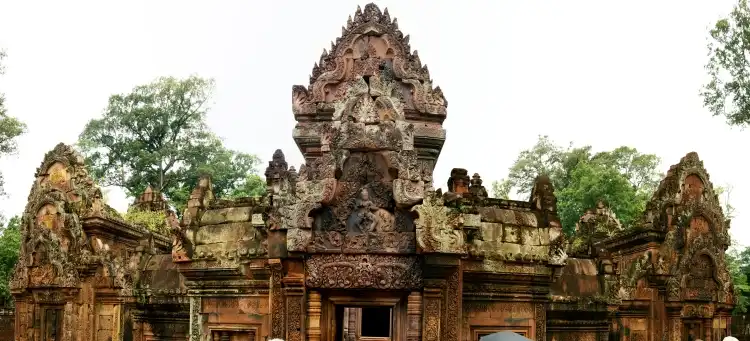
In this way, many beautiful reliefs depicting Hindu legends remain on the gables of Prasat Banteay Srei. The picture below is a scene from the Ramayana, a relief depicting three competing monkey brothers.
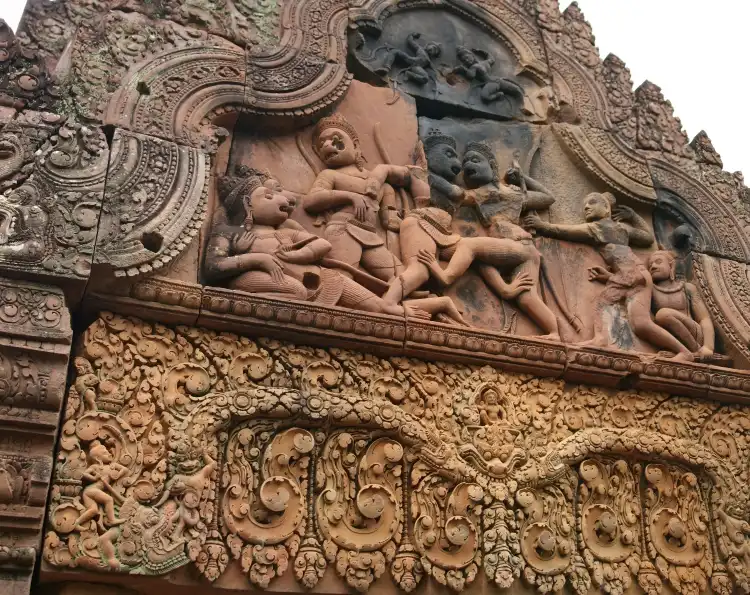
The heart of the temple is, above all, the reliefs and statues of devata (goddess) around the tower of the central shrine. The photo below is the west side of the central shrine. There are multiple devata (goddesses), so please appreciate them.
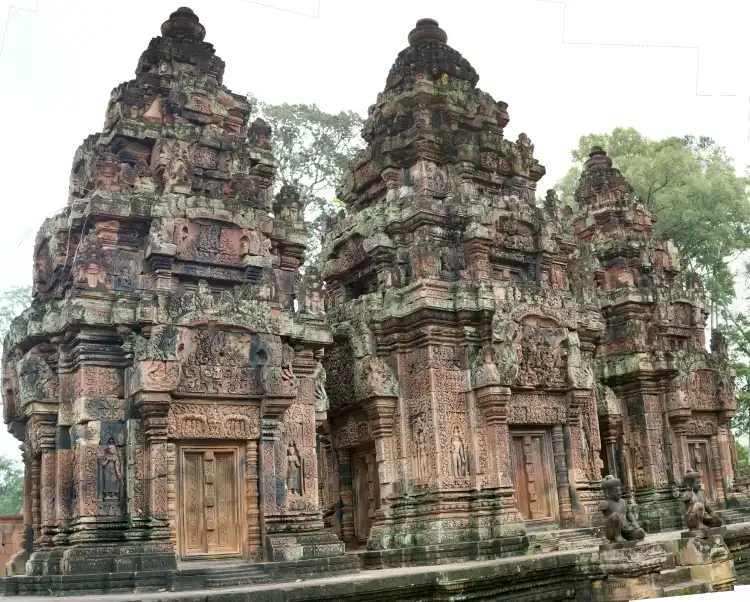
How to Get There
Access is easiest from Siem Reap. Visitors can hire a tuk-tuk, join a guided tour, or rent a bike for a scenic ride through the Cambodian countryside. The journey reveals rural landscapes and offers insights into local life.
Best Time to Visit Banteay Srei
The best time to visit Banteay Srei is during the cooler months from November to February. Early morning can avoid the heat and capture the temple in its best light.
Tours
Prasat Banteay Srei is a very popular temple and numerous tous visit there. Full-Day Banteay Srei & 4 Temples Join-in Tour is one of the most popular tours.
The post Banteay Srei appeared first on Find Asia - Tours in Asia.
Ta Keo, Angkor 18 Feb 2024, 2:33 pm
Despite being unfinished, Ta Keo is a fascinating component of Angkor’s architectural heritage. Its towering presence and unique story make it a must-visit for those exploring Cambodia’s ancient wonders.
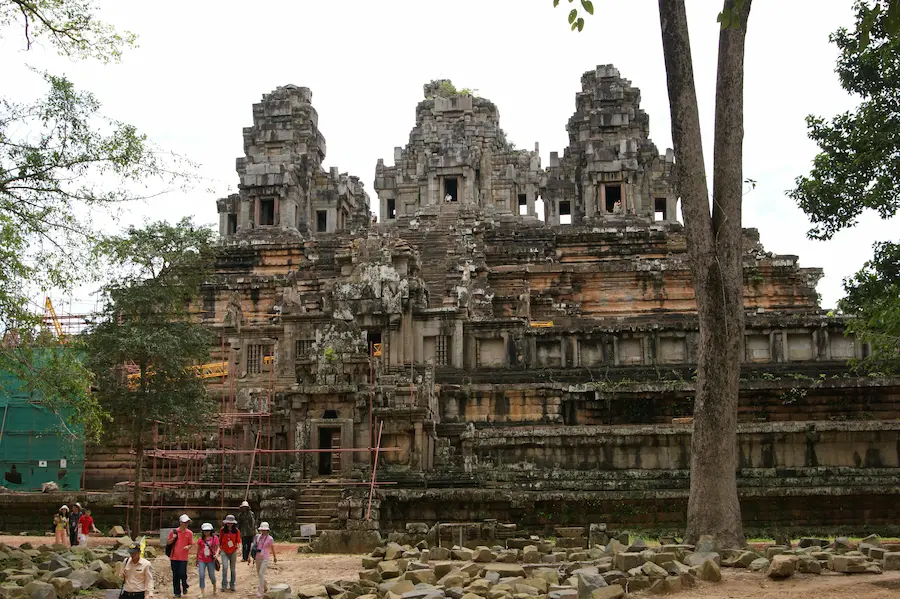
Discovering Ta Keo: The Unfinished Masterpiece of Angkor
Introduction
Ta Keo stands as a monumental testament to the architectural ambition of the Khmer Empire. This temple-mountain, located in the heart of Angkor, Cambodia, is unique for its unfinished state. Yet, it offers a glimpse into the grandeur of ancient Khmer architecture.
Historical Backdrop
Constructed during the reign of King Jayavarman V, Ta Keo’s construction began at the end of the 10th century. It was intended to surpass its predecessors in scale and grandeur. However, its construction halted abruptly, leaving historians to speculate on the reasons. Some suggest a lightning strike during construction was a bad omen.
Architectural Features
Ta Keo’s design is a step pyramid, reaching towards the sky with five towering tiers. It was one of the first Angkor temples to be built entirely of sandstone. This gives it a distinct, majestic appearance. The temple’s five sanctuaries were dedicated to Hindu deities, with the central sanctuary reserved for Shiva.
Exploring Ta Keo
Visitors to Ta Keo can climb its steep stairways, a challenge that rewards with panoramic views of the surrounding jungle. The absence of detailed carvings, typical of completed temples, highlights its unfinished status. Yet, its sheer scale and the precision of its construction are impressive.
Access and Best Times to Visit
Located within the Angkor Archaeological Park, it is easily accessible from Siem Reap. The best times to visit are early morning or late afternoon to avoid the heat and crowds. These times also offer the best light for photography.
Why Visit Ta Keo?
It invites visitors to ponder what could have been. Its unfinished state adds to its mystery and charm. It stands as a testament to the ambition and skill of the Khmer builders. A visit to Ta Keo is a journey back in time, offering insights into the history and culture of the ancient Khmer Empire.
Tours
Many of Angkor Wat tours pass by Ta Keo. It is apparently not the main attraction. If you want to go, take a flexible Tuk tuk private tour. For example, Angkor Wat Temple Tour with own Tuk Tuk Driver and some other tours visit this temple.
The post Ta Keo, Angkor appeared first on Find Asia - Tours in Asia.
Angkor Thom and Bayon 18 Feb 2024, 12:33 pm
Angkor Thom and Bayon stand as enduring symbols of Cambodia’s glorious past. Their grandeur and mystery continue to captivate and intrigue visitors from around the world, offering a window into the soul of the Khmer empire.
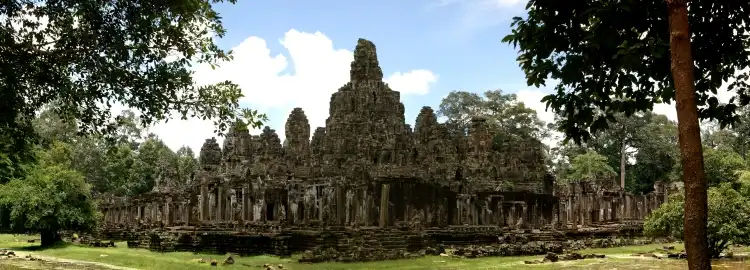
The Last Capital and Its Enigmatic Faces
Angkor Thom: The Majestic City
Angkor Thom, the last and most enduring capital city of the Khmer empire, stands as a monumental testament to Cambodia’s rich history. Founded by King Jayavarman VII in the late 12th century, this ancient city was the center of his massive building program. Enclosed by massive walls and a moat, Angkor Thom was designed to represent the universe in stone, mirroring the cosmic world.
The City’s Grand Entrance
The city is accessible through five grand gates, each adorned with impressive stone faces and figures of gods and demons. The South Gate, the most famous, serves as the main entrance, offering a preview of the marvels within. Crossing the causeway lined with statues depicting the churning of the ocean of milk sets the tone for the awe-inspiring sights that await.

Bayon: The Temple of Faces
At the heart of Angkor Thom lies the Bayon Temple, known for its serene and smiling stone faces. This temple, unlike any other at Angkor, is a symbolic representation of the intersection of heaven and earth. The Bayon’s most distinctive feature is the more than 200 gigantic faces carved on the 54 towers. The faces gaze down with an enigmatic smile. They are believed to be either the face of King Jayavarman VII or that of the bodhisattva Avalokiteshvara. Or perhaps a combination of both.

Exploring the Bayon
Visitors to the Bayon can wander through its complex interior and exterior galleries. The outer galleries showcase intricate bas-reliefs depicting historical events and daily life in the Khmer empire. It offers a glimpse into the past. The central sanctuary, with its labyrinth of corridors, courtyards, and chambers, invites exploration and contemplation.
Angkor Thom’s Other Highlights
Beyond Bayon, Angkor Thom is home to other notable structures. The Terrace of the Elephants and the Terrace of the Leper King were used for public ceremonies and are adorned with detailed carvings. Phimeanakas, Baphuon, and Preah Palilay offer further insights into the architectural and religious complexity of the Khmer empire.
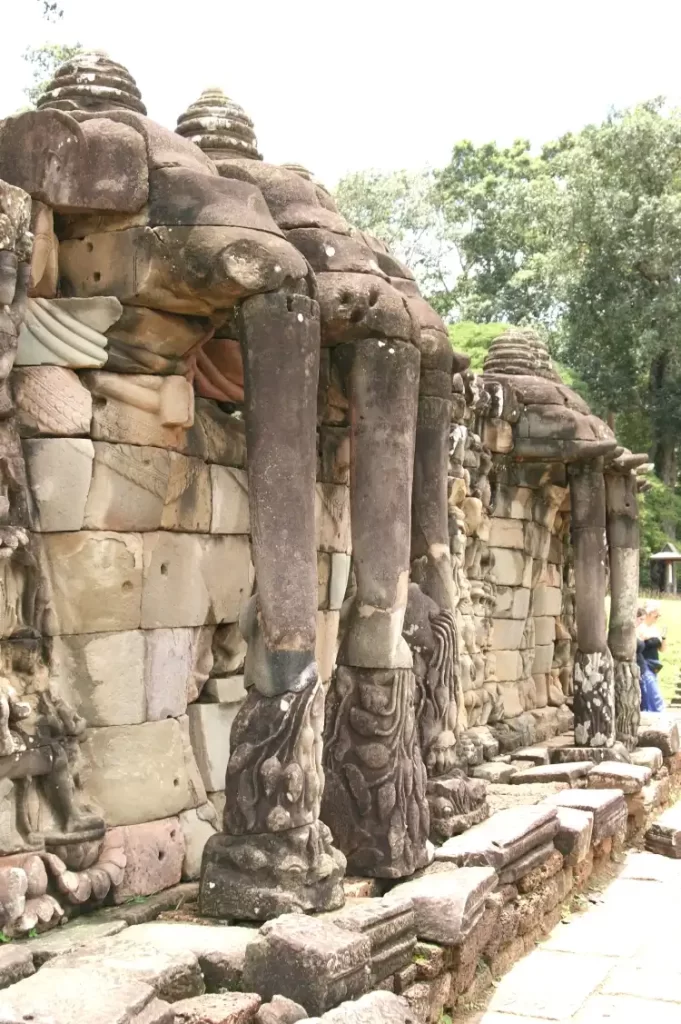
Visiting Tips
Angkor Thom is best explored early in the morning or late in the afternoon to avoid the heat and crowds. Hiring a knowledgeable guide enhances the experience, providing insights into the history, architecture, and symbolism of these ancient wonders.
Cultural Respect
When visiting, it’s important to dress modestly and behave respectfully. These sites are not only tourist attractions but also places of cultural and spiritual significance.
Tours
Most of the Angkor Wat tours also include a visit to Angkor Thom. Group tours and private tours are available, but flexible private tours are recommended.
Private Temples Guided Tour (Angkor Wat, Ta Prom & Angkor Thom) is a concise tour covering three major temples.
More images of Angkor Thom and Bayon are available here.
The post Angkor Thom and Bayon appeared first on Find Asia - Tours in Asia.
Angkor Wat 18 Feb 2024, 12:06 pm
Angkor Wat is a testament to human creativity and devotion. Its beauty and scale captivate all who visit. This temple complex is not just a relic of the past but a living monument that continues to inspire and awe.
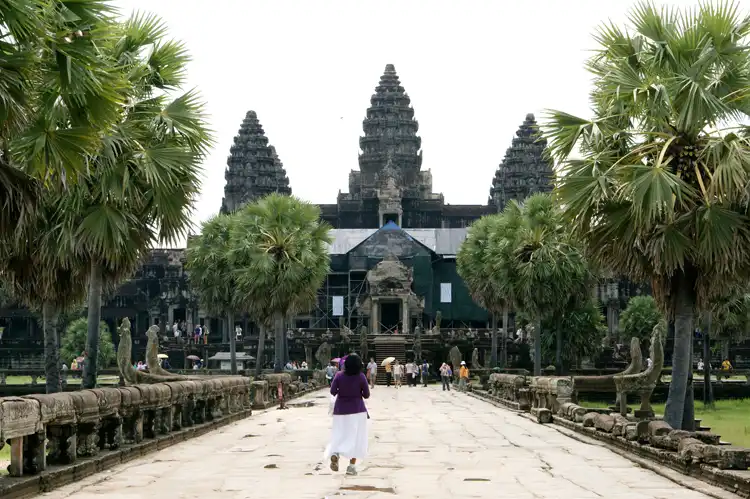
Angkor Wat: A Monument to Eternity
Introduction to Angkor Wat
Angkor Wat stands as a symbol of Cambodia’s heart and soul. Located in the Angkor archaeological park, this temple complex is the largest religious monument in the world. It was originally constructed in the early 12th century as a Hindu temple dedicated to Vishnu. Over time, it transformed into a Buddhist temple.
Architectural Marvel
Angkor Wat’s architecture is a marvel of engineering and artistry. Its layout mirrors the Hindu cosmological universe, with central towers representing Mount Meru, the home of the gods. The temple is famous for its intricate bas-reliefs and carvings, depicting Hindu epics and mythology.
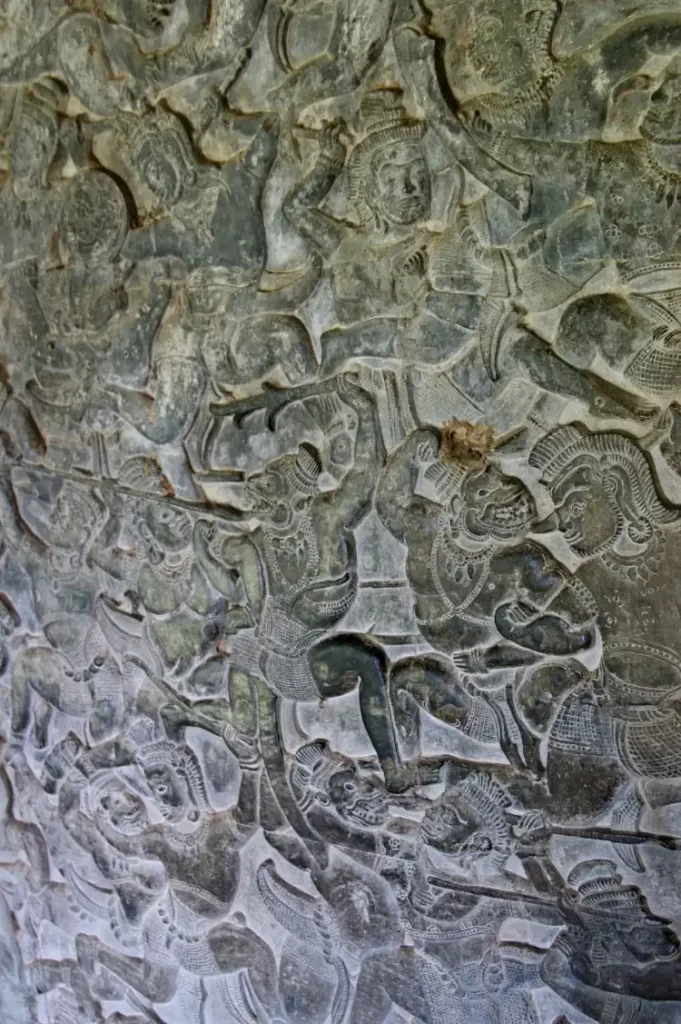
Exploring the Temple
Visitors enter Angkor Wat through a Naga bridge, symbolizing the rainbow bridge that connects the human world to the divine. The complex is surrounded by a vast moat, representing the ocean surrounding Mount Meru.

Inside, the temple’s galleries, courtyards, and central towers offer a journey through time and spirituality.
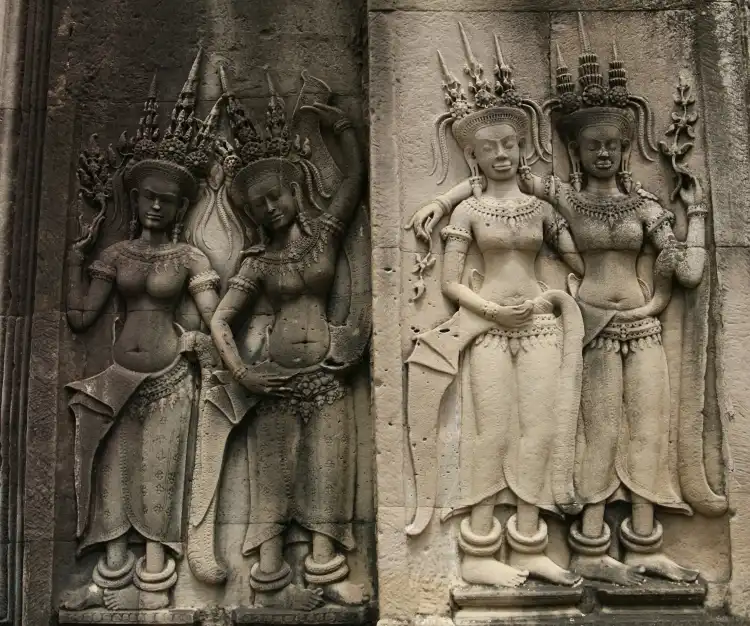
Sunrise at Angkor Wat
A highlight for many is witnessing sunrise at Angkor Wat. This magical moment, when the sun rises behind the temple’s silhouette, offers unparalleled beauty and tranquility. It’s a must-do for photographers and spiritual seekers alike.
Conservation Efforts
this temple is not just a tourist destination but a monument in need of protection. Conservation efforts are ongoing to preserve its structures against time and tourism. Visitors should respect the site by following guidelines, such as not touching the carvings and staying on designated paths.
Access
Located near Siem Reap, Angkor Wat is accessible by tuk-tuk, bike, or car. Tickets to the archaeological park cover entrance to Angkor Wat and other temples in the area. Planning a visit early in the morning or late afternoon avoids the peak heat and crowds.
Cultural Significance
Angkor Wat is more than an architectural wonder; it’s a symbol of Cambodian resilience and pride. It appears on the national flag, representing the soul of the Khmer people. The temple is a place of pilgrimage for both Buddhists and Hindus, reflecting Cambodia’s rich religious heritage.
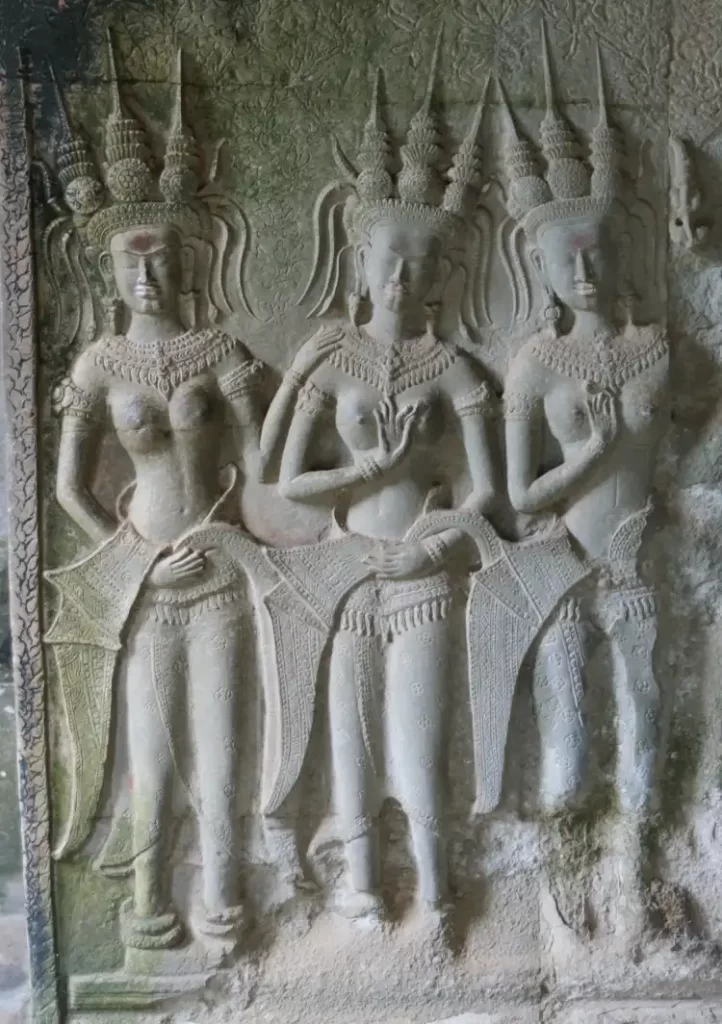
Tours
There are a tremendous number of tours starting from Siem Reap (check here for a full list). There are several types of tours: those that visit only Angkor Wat temples, those that visit temples in the center of Angkor called “Small circuit”, those that visit temples at a distance from Angkor Wat temples called “Grand circuit”.
Small circuit includes Angkor Wat, Phnom Bakheng, Angkor Thom, South Gate, Baphuon, Phimeanakas, Terrace of the Leper King, Terrace of the Elephants, Victory Gate, Ta Keo, Ta Prohm, Banteay Kdei, Srah Srang and Prasat Kravan. Grand circuit includes Pre Rup, East Mebon, Ta Som, Neak Pean, Prasat Prei, Preah Khan, North Gate and West Mebon.
Other tours visit temples at a distance from Angkor center such as Banteay Srei, Beng Mealea, Kbal Spean and those belong to Roluos Group.
The post Angkor Wat appeared first on Find Asia - Tours in Asia.
Petra 18 Feb 2024, 8:40 am
Petra remains one of the world’s most compelling archaeological sites, offering a window into the past of human ingenuity and endurance. Its breathtaking beauty and historical significance make it a must-visit destination for travelers to Jordan.

Petra: Jordan’s Ancient Desert Wonder
Petra, also known as the Rose City due to the color of its stone, is an archaeological site in Jordan’s southwestern desert. Dating back to around 300 B.C., it was the capital of the Nabatean Kingdom. Today, Petra is a UNESCO World Heritage site and one of the New Seven Wonders of the World.
The Siq and The Treasury
The journey into Petra begins with the Siq, a narrow gorge that leads to the city’s most iconic structure, the Treasury (Al-Khazneh). This stunning facade, carved directly into the pink sandstone cliff face, is believed to have been a mausoleum or a treasury for the Nabatean King Aretas IV.
Beyond the Treasury
Beyond the Treasury, Petra opens up into a vast city of tombs, temples, and intricate buildings. Key sites include the Street of Facades, the Royal Tombs, and the Roman-style Theatre that could seat 3,000 spectators.
The Monastery (Ad Deir)
A climb of over 800 steps from the city center leads to the Monastery (Ad Deir). Larger than the Treasury, this monument offers breathtaking views of the surrounding mountains and valleys.
Cultural Significance and Preservation
Petra’s architecture and water conduit system reflect the Nabateans’ advanced understanding of engineering and water management. Efforts are ongoing to preserve these ancient structures from natural erosion and human damage.
Best Time to Visit
The best time to visit Petra is during spring (March to May) or autumn (September to November). These seasons offer milder temperatures, making the exploration of this vast site more comfortable.
Tips for Visitors
Visitors should prepare for a lot of walking, often on uneven terrain. Wearing comfortable shoes, carrying water, and using sun protection are essential. Hiring a local guide can enhance the experience with insights into the site’s history and legends.
If you are interested in history, visit the Petra Museum. Visitors can see the actual water pipes that used to supply water to Petra. Visitors can also understand the changes that have taken place in the region over time. You can also learn about the Nabateans, who built a civilization in this region.
Tours
Many tours that visit Petra originate in Amman. Both day tours and 2-day tours that spend the night there are available. If you want to do a day trip, From Amman: Private full day Petra and Wadi rum is an affordable option. The 3-Day Private Tour from Amman: Petra, Wadi Rum, Dana, Aqaba, and Dead Sea takes you to the Dead Sea.
The post Petra appeared first on Find Asia - Tours in Asia.
Kandy 18 Feb 2024, 7:03 am
Kandy is a city where history, culture, and natural beauty converge. It offers a unique blend of experiences, from sacred temples and vibrant festivals to serene gardens and tea estates. A visit to Kandy is a journey through the soul of Sri Lanka.
Kandy: The Cultural Heart of Sri Lanka
Kandy, nestled in the hills of central Sri Lanka, is a city rich in history and culture. Known as the last capital of the ancient kings’ era, Kandy is a UNESCO World Heritage site. It’s famous for the Temple of the Tooth Relic, vibrant festivals, and scenic beauty.
Historical Significance and Attractions
The Temple of the Tooth, housing the sacred tooth relic of the Buddha, is Kandy’s most revered site. Pilgrims and tourists alike are drawn to its rituals and architecture. The city’s historical significance is further highlighted by the Royal Palace and Kandy Lake, offering glimpses into Sri Lanka’s royal past.
Cultural Festivals
The Esala Perahera, a grand festival held in July or August, showcases Kandy’s rich cultural heritage. This event features traditional dances, elaborately decorated elephants, and thousands of performers, attracting visitors from around the world.
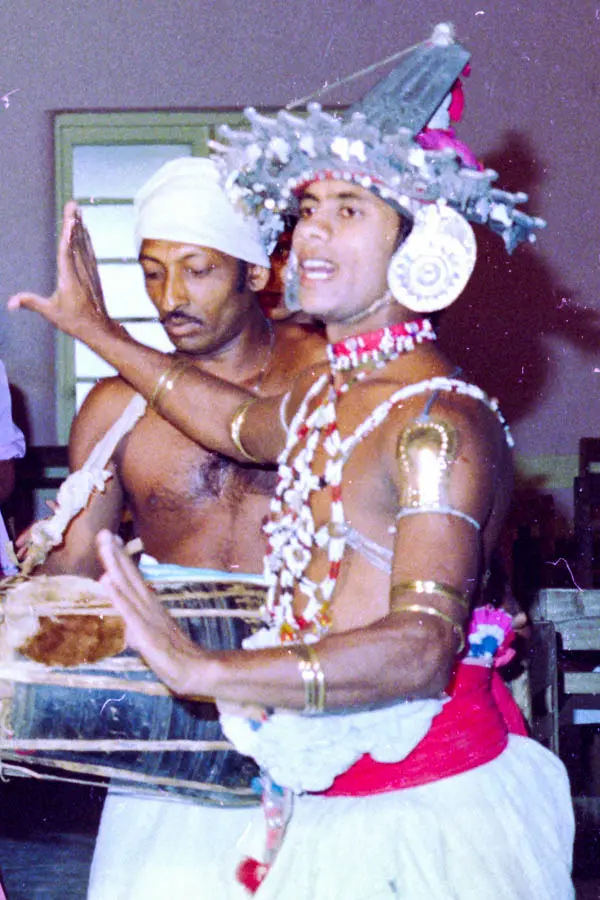
Natural Beauty and Leisure
Kandy is surrounded by lush mountains and tea plantations. The Peradeniya Botanical Gardens, just outside the city, boast a vast collection of flora, including an impressive orchid collection. The gardens are a peaceful retreat from the city’s hustle and bustle.
Culinary Experiences
Kandy offers a variety of culinary delights, from traditional Sri Lankan cuisine to international dishes. Local favorites include rice and curry, kottu, and hoppers. Tea lovers can enjoy some of the world’s best Ceylon tea, fresh from nearby plantations. There are also many cooking courses that you can participate in.
Access and Best Time to Visit
This city is accessible by road, rail, and air, with the nearest airport in Colombo. The city’s climate is pleasant year-round, but the best time to visit is from December to April, when the weather is cooler and dryer.
Tours
Since Kandy is a small town, there are not many tours within the town. Half-Day Kandy City Tour by Tuk Tuk is a good one.
On the other hand, Kandy is the starting point for tours to Sigiriya and Polonnaruwa in northern Sri Lanka.
The post Kandy appeared first on Find Asia - Tours in Asia.
Annapurna Base camp trekking 18 Feb 2024, 6:31 am
The Annapurna Base Camp Trek is an unforgettable adventure that offers a mix of natural beauty, cultural richness, and physical challenge. It’s an opportunity to immerse oneself in the beauty of the Himalayas and experience the warmth of Nepalese hospitality.
Annapurna Base Camp Trek: A Journey Through the Heart of the Himalayas
The Annapurna Base Camp Trek is a stunning journey to the foot of the Annapurna massif. This trek is renowned for its diverse landscapes, rich cultural experiences, and breathtaking views of some of the world’s highest peaks.
The Trekking Experience
The trek typically starts from Pokhara, leading adventurers through lush rhododendron forests, traditional Gurung and Magar villages, and up to the Annapurna Base Camp at 4,130 meters. Along the way, trekkers will see majestic views of Annapurna I, Annapurna South, Machapuchare (Fishtail), and Hiunchuli.
Highlights and Key Landmarks
Key highlights include the hot springs at Jhinu Danda, the deep gorge of the Modi Khola river, and the Machapuchare Base Camp. The 360-degree views from Annapurna Base Camp itself are unforgettable, offering a panorama of towering peaks and glaciers.
Cultural Insights
The trek provides a deep dive into the life of the local Gurung and Magar communities. Trekkers can learn about traditional Himalayan lifestyles, enjoy local hospitality, and participate in cultural exchanges.
Physical Preparation and Best Time to Trek
This Trek is moderate in difficulty. It requires good physical fitness but is accessible to most people with proper preparation. The best times to trek are during the pre-monsoon (March to May) and post-monsoon (September to November) seasons, offering clear skies and temperate weather.
Sustainable Trekking Practices
Visitors should practice sustainable trekking. This includes respecting local customs, minimizing environmental impact, and supporting eco-friendly lodges.
Tours
This trek is one of the shorter trekking trails in Nepal. On the other hand, it is close to Annapurna, an 8,000-meter peak, and offers an authentic view of the Himalayas. The starting point for the tours is the town of Pokhara.
Annapurna base camp trek 5 Days is available from Kathmandu.
If you have the time and energy, try the Annapurna Circuit Trek.
The post Annapurna Base camp trekking appeared first on Find Asia - Tours in Asia.
Annapurna circuit trekking 18 Feb 2024, 6:18 am
The Annapurna Circuit Trek is a journey of a lifetime, offering an unparalleled mix of adventure, natural beauty, and cultural enrichment. It challenges and rewards trekkers with its stunning landscapes, diverse ecosystems, and warm hospitality, making it a must-do for any trekking enthusiast.
Annapurna Circuit Trek: A Journey Through the Heart of the Himalayas
The Annapurna Circuit Trek is one of the most popular and diverse treks in Nepal, offering an unforgettable journey through breathtaking landscapes, diverse cultures, and challenging terrains. Circling the Annapurna massif, this trek provides a unique blend of natural beauty and cultural richness.
The Route and Its Wonders
The trek traditionally begins in Besisahar or Bhulbhule and concludes in the Kali Gandaki Gorge, the world’s deepest. It takes trekkers through subtropical forests, paddy fields, and high-altitude landscapes. The pass crosses the Thorong La Pass at 5,416 meters, the highest point of the trek.
Cultural Diversity
The circuit passes through various villages inhabited by different ethnic groups, including Gurung, Manangi, and Thakali communities. Trekkers can experience the local hospitality, traditional lifestyles, and cultural practices firsthand, making for a rich cultural immersion.
Flora and Fauna
The diverse climate zones of the trek, from tropical to arctic, host a wide variety of flora and fauna. Trekkers can witness rhododendron forests, pine woods, and a range of wildlife. It includes snow leopards and Himalayan tahr, in their natural habitats.
Physical Preparation and Challenges
The Annapurna Circuit is physically demanding, with long trekking days and significant altitude changes. Adequate preparation, including physical conditioning and acclimatization to prevent altitude sickness, is essential for a successful trek.
Best Time to Visit
The best times are during the spring (March to May) and autumn (September to November). These months offer the clearest skies, the most stable weather, and the best views of the Annapurna range.
Sustainable Trekking Practices
As the circuit becomes more popular, sustainable trekking practices are crucial to preserve its natural and cultural assets. Trekkers should minimize their environmental impact and support local economies by staying in local teahouses and hiring local guides.
Tours
In the past, snow-related mishaps have occurred on this trail. Therefore, it is strongly recommended to join a guided tour. The Annapurna Circuit Trek is a 14-day tour. Some longer tours can take up to 18 days.
If you do not have time for the Annapurna circuit trek, we recommend a trek to Annapurna base camp.
If you have completed the Annapurna Circuit, then by all means do the Everest Base Camp Trek.
The post Annapurna circuit trekking appeared first on Find Asia - Tours in Asia.
Everest Base Camp trekking 18 Feb 2024, 6:02 am
The Everest Base Camp Trek is more than an adventure; it’s a life-changing experience. It offers unparalleled natural beauty, a chance to test one’s limits, and a unique cultural immersion. For many, it’s a journey of self-discovery at the top of the world.

Everest Base Camp Trekking: Journey to the Roof of the World
The Everest Base Camp Trek is an iconic journey that takes adventurers to the base of the world’s highest peak, Mount Everest. This trek is not just about reaching a destination; it’s about experiencing the heart of the Himalayas, the culture of the Sherpa people, and the challenges and triumphs of high-altitude trekking.
The Route and Its Highlights
Starting from Lukla, trekkers follow a trail that winds through the Khumbu region. The path leads through ancient Sherpa villages, verdant forests, and across suspension bridges. Key highlights include Namche Bazaar, the Tengboche Monastery, and the stunning viewpoints of Kala Patthar and Everest Base Camp itself.
Cultural Immersion and Sherpa Heritage
The trek offers a deep dive into Sherpa culture. Trekkers can visit monasteries, interact with local communities, and learn about the Sherpa’s rich history and traditions tied to the Himalayas.
Physical Demands and Preparation
The Everest Base Camp Trek is challenging. It requires good physical fitness and acclimatization to high altitudes. Preparation should include cardiovascular training, strength exercises, and hiking practice. Acclimatization days are built into the trek to help adventurers adjust to the elevation.
Best Time to Visit
The best times for the trek are during the pre-monsoon season (March to May) and post-monsoon season (September to November). These periods offer clearer skies, safer trails, and the best views of Everest and the surrounding peaks.
Environmental and Cultural Respect
Trekkers are urged to follow Leave No Trace principles to protect the environment. Respecting local customs and traditions is also crucial for a harmonious journey.
Trekking tours
It is possible to make our way to Everest on our own. However, it takes a lot of preparation in advance and requires a lot of physical strength. What is recommended is to take a tour with a guide or porter. Because of the altitude acclimatization required, the tour takes two weeks round trip from Kathmandu.
Everest Base Camp Trekking tour is one of the most popular tours. It takes 14 days including arrival and departure days.
The post Everest Base Camp trekking appeared first on Find Asia - Tours in Asia.
Taj Mahal tours 18 Feb 2024, 5:05 am
The Taj Mahal is not just a monument but a symbol of love and a masterpiece of architectural beauty. Its timeless allure draws visitors from around the world, making it a must-see destination in India.
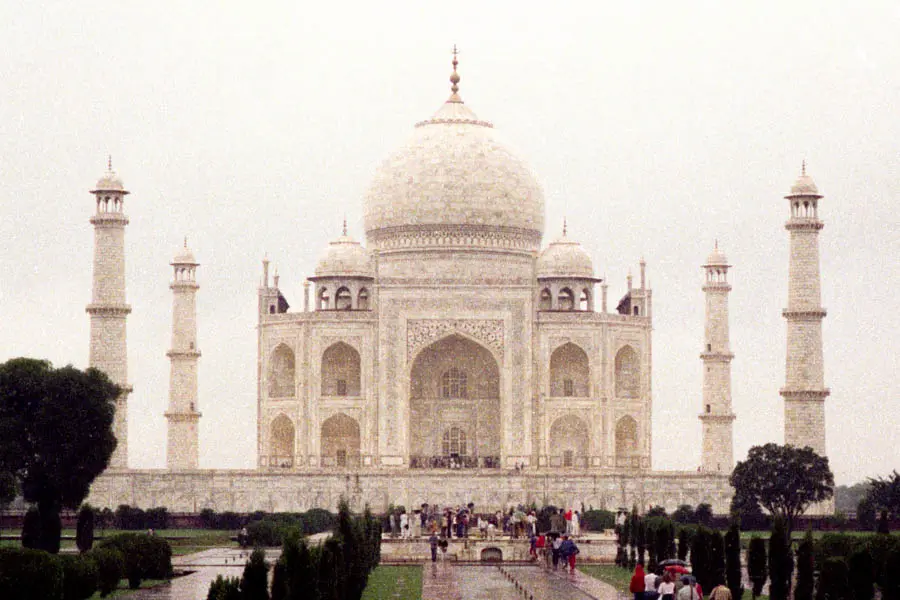
Taj Mahal: India’s Iconic Symbol of Love
The Taj Mahal, located in Agra, India, is a marvel of Mughal architecture. This UNESCO World Heritage site symbolizes the eternal love of Emperor Shah Jahan for his wife Mumtaz Mahal.
Architectural Masterpiece
Constructed from white marble, the Taj Mahal took over 20 years to complete, from 1632 to 1653. Its design combines elements from Islamic, Persian, Ottoman Turkish, and Indian architectural styles.
Visiting the Taj Mahal
The complex includes the main mausoleum, gardens, a mosque, and a guest house. The best time to visit is at sunrise or sunset when the marble reflects the hues of the sky.
The Main Mausoleum
The mausoleum’s interior houses the cenotaphs of Mumtaz Mahal and Shah Jahan. Intricate inlay work and calligraphy adorn the surfaces, showcasing the craftsmanship of the era.
Gardens and Outlying Buildings
The building stands within a formal Mughal garden. To its east and west are a mosque and a guest house, symmetrically balancing the design.
Environmental Considerations
Efforts are ongoing to protect the Taj Mahal from environmental impacts. Visitors are encouraged to respect the site’s rules to help preserve its beauty.
Best Time to Visit
The cooler months, from November to February, offer the most pleasant weather for visiting. Monsoon season, from July to September, can bring heavy rains. Remember, it is closed on Fridays for prayers.
Tips for Visitors
Early morning visits offer fewer crowds and the best light for photography. From Delhi, sunrise tours are also available.
Tours
Many tours available from New Delhi, the capital of India. There are day tours as well as multi-day tours that visit several places in India. If you are a budget traveler, then Taj Mahal Day Tour from Delhi by Superfast Train is recommended.
The post Taj Mahal tours appeared first on Find Asia - Tours in Asia.
Sigiriya Rock 18 Feb 2024, 4:22 am
Sigiriya Rock is not just a site of historical and archaeological significance. It’s a journey back in time. Its combination of natural beauty and human creativity makes it a must-visit destination in Sri Lanka.
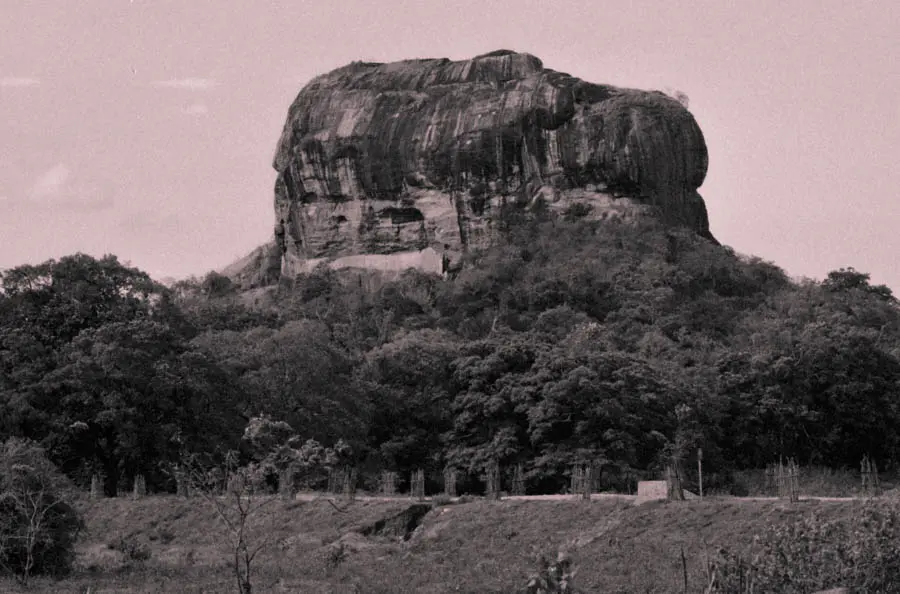
Sigiriya Rock: Sri Lanka’s Ancient Wonder
Sigiriya Rock, also known as Lion Rock, is a majestic fortress and palace ruins in central Sri Lanka. This UNESCO World Heritage site is a testament to ancient urban planning, art, and architecture.
The Majestic Rock and Its History
Sigiriya stands about 200 meters high, offering breathtaking views. King Kasyapa (477-495 CE) chose this site for his capital. He built a palace atop the rock and decorated its sides with colorful frescoes.
Climbing Sigiriya Rock
The climb to the top is a journey through history. Visitors pass gardens, fountains, and the famous Mirror Wall. Halfway up, the Lion Gate, with its massive lion paws, marks the entrance to the summit.
Frescoes and Mirror Wall
The Sigiriya frescoes, depicting celestial maidens, are a highlight. The Mirror Wall, once polished to reflect the king himself, now holds inscriptions from as early as the 8th century.
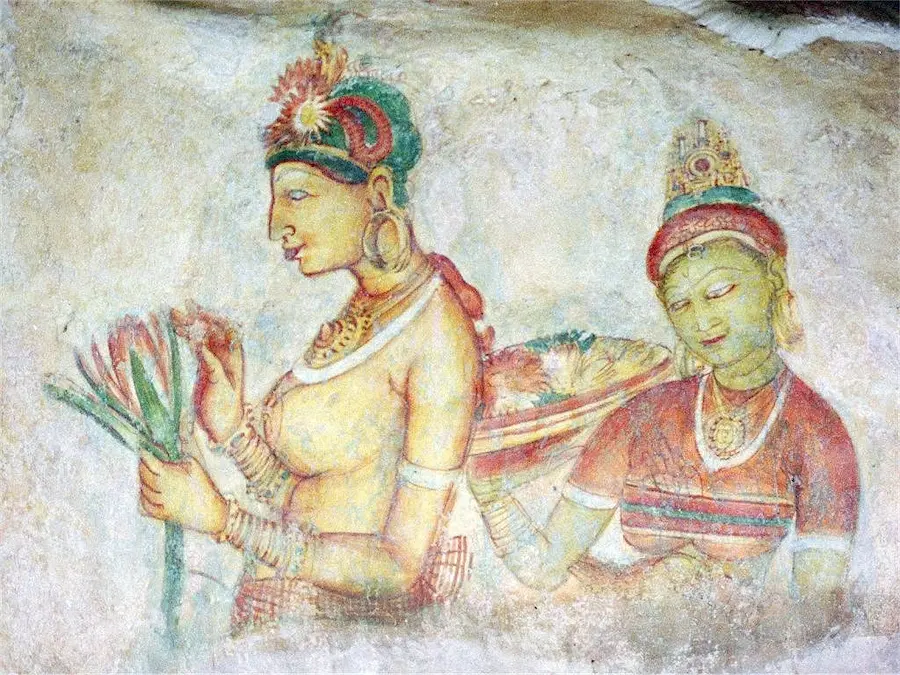
The Summit and Water Gardens
The summit reveals the palace ruins and panoramic views of the surrounding jungle. The water gardens at the base are engineering marvels, with symmetrical pools and fountains.
Best Time to Visit
The best time to visit Sigiriya is during the cooler months, from December to April. Early morning climbs are recommended to avoid the heat and crowds.
Day Trips and Nearby Attractions
Sigiriya is a great starting point for exploring Sri Lanka’s Cultural Triangle. Nearby Dambulla features cave temples with Buddhist murals and statues. The ancient cities of Polonnaruwa and Anuradhapura are also within reach.
Tours
There are day tours available from Colombo and Kandy. Most of the tours also visit Dambulla caves.
If you stay in Colombo, then Full Day Tour to Sigiriya and Dambulla from Colombo is a good tour. If you are in Kandy, try Day tour to Sigiriya,Dambulla & Polannaruwa (3 word heritage places) from Kandy.
The post Sigiriya Rock appeared first on Find Asia - Tours in Asia.
Da Nang, Vietnam 18 Feb 2024, 2:38 am
Da Nang is a city that combines the allure of beaches with cultural depth. Whether you’re seeking adventure or relaxation, it promises an unforgettable experience.

Discover Da Nang: Vietnam’s Must-Visit Coastal City
Da Nang stands as a vibrant gem on Vietnam’s central coast. This city blends modernity with rich history, offering tourists a unique experience. From pristine beaches to cultural landmarks, This city has something for everyone.
Pristine Beaches and Natural Wonders
My Khe Beach is a highlight, famous for its soft white sands and clear waters. It’s perfect for swimming, surfing, and sunbathing.
Just a short drive away, the Marble Mountains offer caves, temples, and panoramic views.
Cultural and Historical Sites
The city is home to the iconic Dragon Bridge, which breathes fire and water on weekends. The Museum of Cham Sculpture displays ancient artifacts, showcasing the area’s rich heritage.
Modern Attractions and Cuisine
The Sun World Ba Na Hills is a must-visit. This resort features the Golden Bridge, held aloft by giant hands. Da Nang’s culinary scene is diverse, offering local specialties like Mi Quang and fresh seafood.
Access and Best Time to Visit
This city is easily accessible by air, with an International Airport serving as a main hub. There are so many daily domestic flights between this city and Hanoi and Ho Chi Minh Cities.
The best time to visit is from February to May, when the weather is mild and pleasant.
Day Tours from Da Nang
There are not many tours that actually go around the city itself. If you are looking for one, try Da nang City Private Tour Half-day.
For those looking to explore beyond, Hoi An, My Son and Hue are excellent day trips. Actually Da Nang is a hub city for visiting various places in the central Vietnam.
Hoi An offers charming streets and ancient architecture, while Hue boasts historic monuments and royal palaces. My Son ruins is a good place for those who are interested in disappeared ancient cultures.
The post Da Nang, Vietnam appeared first on Find Asia - Tours in Asia.
Hue: Vietnam’s Ancient Capital 18 Feb 2024, 2:16 am
Hue offers a deep dive into Vietnam’s imperial past, coupled with natural beauty and culinary delights. It’s a city where history lives on, inviting travelers to explore its rich heritage and tranquil landscapes.
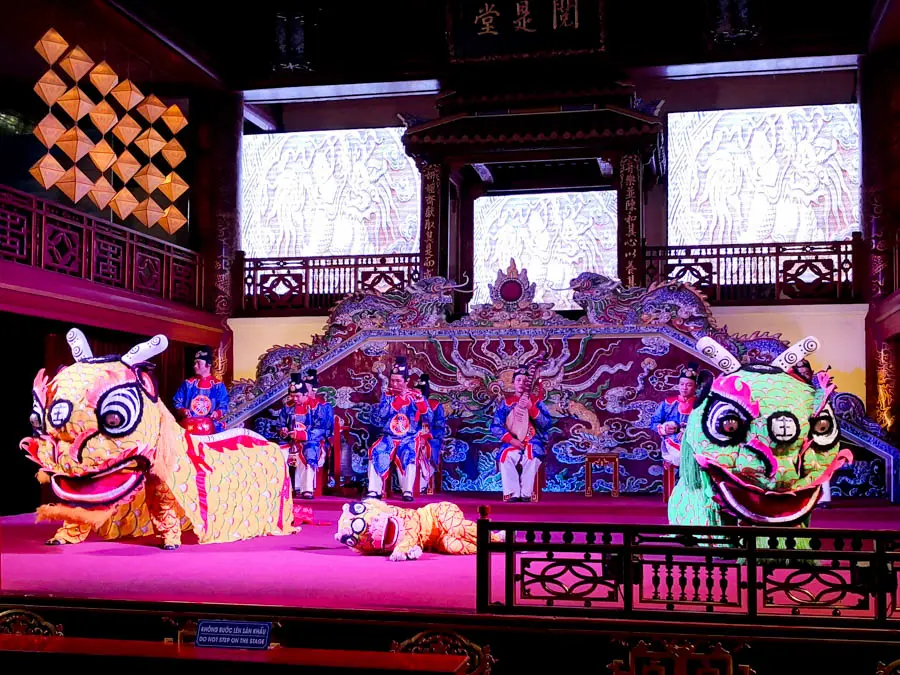
A Glimpse into Hue’s Rich History
Hue, once the imperial capital of Vietnam, stands as a city of historical significance. From 1802 to 1945, it was the political and cultural heart of the Nguyen dynasty. The city’s architecture and culture reflect centuries of Vietnamese history.
Hue’s Imperial City: A Must-Visit
At the core of Hue is the Imperial City, a vast complex of palaces, temples, and walls. This UNESCO World Heritage Site is famous for its magnificent gates and well-preserved buildings. A tour here takes you back in time to the era of emperors and royal ceremonies.
Tranquil Beauty of the Perfume River
The Perfume River winds through Hue, adding to the city’s serene beauty. A boat trip on this river offers stunning views of the sunset and the city’s landmarks. It’s also the best way to reach the Thien Mu Pagoda, an iconic seven-story temple.
Delving into the Royal Cuisine
Hue is renowned for its royal cuisine, once prepared for emperors. Dishes like Banh Beo (steamed rice cakes) and Bun Bo Hue (spicy beef noodle soup) are must-tries. These delicacies reflect the city’s culinary heritage and are available in many local eateries.
The Tombs of the Nguyen Emperors
Surrounding Hue, several tombs of Nguyen emperors are scattered across the countryside. These tombs, each unique in design, offer insights into the personal tastes of the emperors. The Tomb of Tu Duc and Minh Mang’s Tomb are particularly noteworthy for their blend of architecture and natural landscapes.
Embracing Hue: Festivals and Traditions
Hue’s cultural calendar is filled with festivals, the most famous being the Hue Festival. This biennial event showcases traditional music, performances, and crafts, drawing visitors from around the world. It’s a vibrant expression of Hue’s enduring cultural legacy.
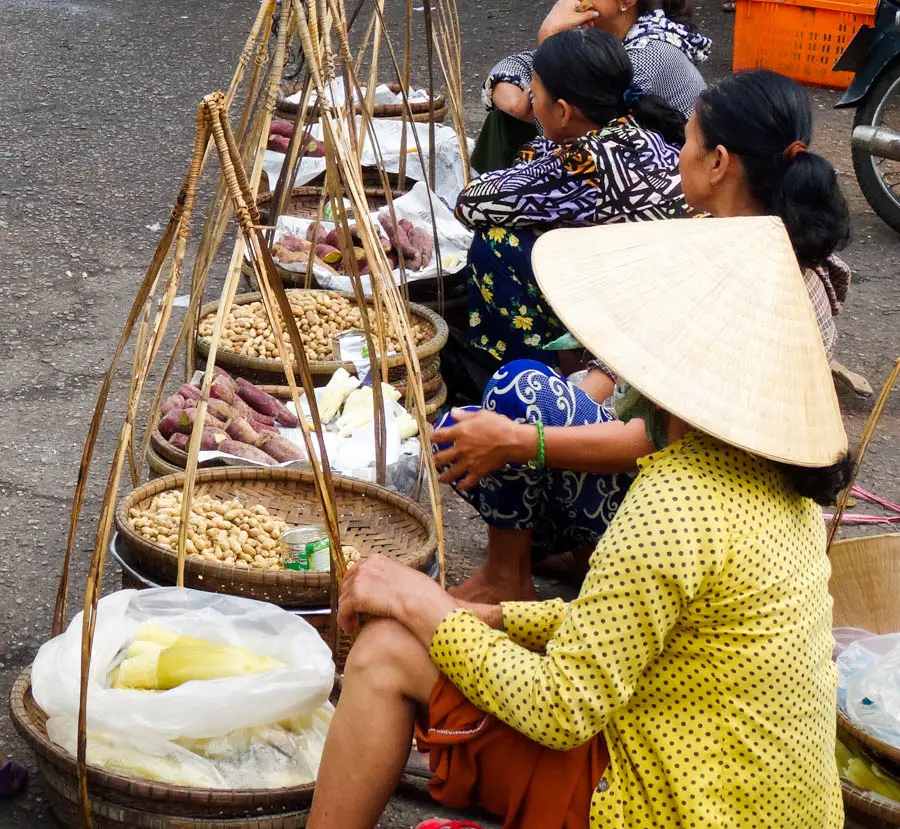
Practical Information for Visitors
Getting to Hue is easy, with options including flights, trains, and buses from major cities like Hanoi, Da Nang and Ho Chi Minh City. Within Hue, cycling is a popular way to explore, offering a closer look at the city’s charm. Accommodations range from budget hostels to luxurious hotels, catering to all preferences.
Transport only service is also available from Hoi An and Da Nang.
Tours
Tours are available within Hue city as well as big cities such as Da Nang. Imperial City Private Tour with Local Experts departs from Da Nang. This is one of the highly rated tour. So, if you have a chance, try it!
The post Hue: Vietnam’s Ancient Capital appeared first on Find Asia - Tours in Asia.
Hoi An tours, Vietnam 18 Feb 2024, 1:38 am
Hoi An is a must-visit destination in Vietnam, offering a glimpse into the country’s past while celebrating its present. Whether interested in history, food, or culture, Hoi An has something for everyone.
Discover Hoi An: A Timeless Charm in Vietnam
Introduction to Hoi An
Hoi An, a UNESCO World Heritage Site, stands as a testament to Vietnam’s rich history. This ancient town offers a blend of indigenous and foreign influences, visible in its architecture and culture. Once a bustling trading port from the 15th to the 19th century, The town now attracts visitors with its well-preserved buildings, vibrant lantern-filled streets, and unique heritage.
Exploring the Old Town
The heart of Hoi An is its Old Town. Here, history comes alive. Visitors can explore the Japanese Covered Bridge, a symbol of the old town, dating back to the 18th century. The town is also home to ancient temples, colonial shop houses, and bustling markets. Walking tours are popular, allowing travelers to immerse themselves in the town’s historic charm.
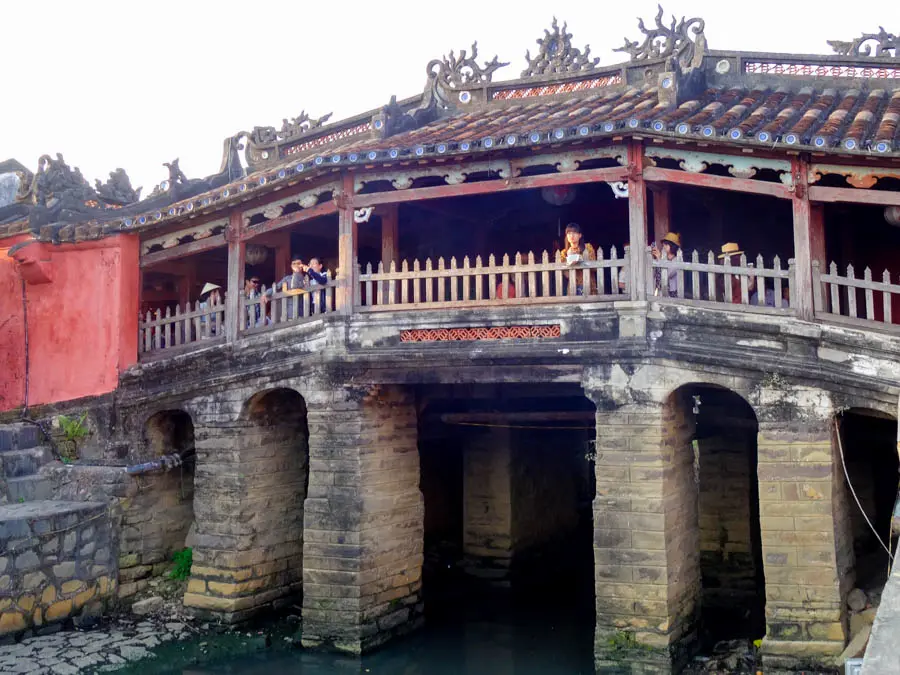
Culinary Delights
Hoi An is renowned for its culinary scene. The town offers dishes not found elsewhere in Vietnam. Must-try foods include Cao Lầu, a noodle dish unique to the town, and Bánh Mì Hội An, a local take on the Vietnamese sandwich. Street food tours provide a taste of region’s rich flavors.
Hoi An Lantern Festivals
The Lantern Festival is a monthly highlight in old town. On the full moon, the town switches off its electric lights and illuminates with thousands of lanterns. This tradition creates a magical atmosphere, drawing visitors and locals alike to the riverside for a night of celebration.
Crafts and Workshops
Hoi An is a hub for traditional crafts. Visitors can attend workshops on lantern making, pottery, and wood carving. These sessions offer a hands-on experience of the town’s artisanal heritage.
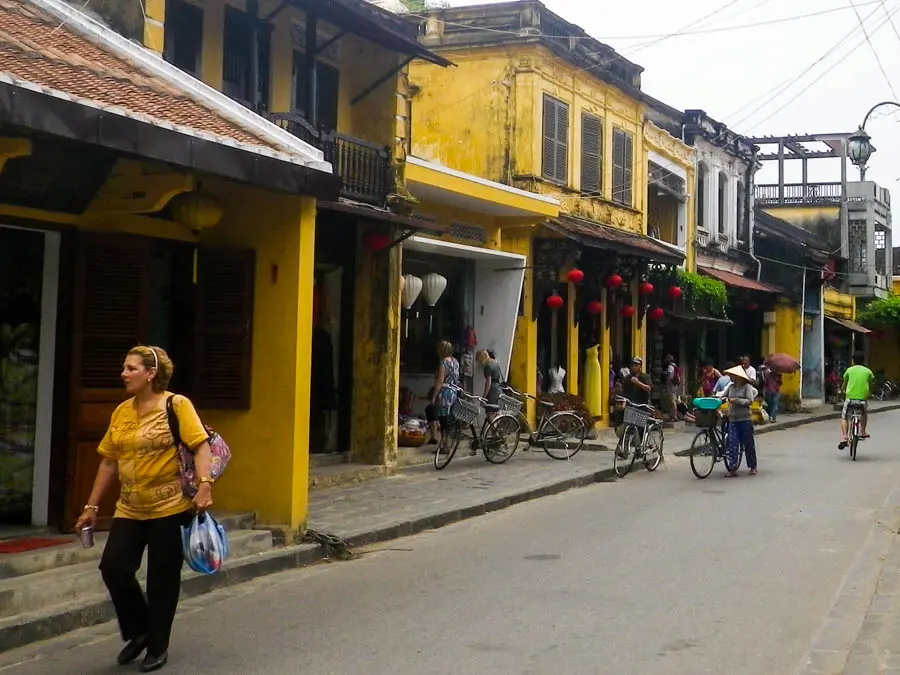
Nearby Attractions
Beyond the town, the surrounding region offers attractions like the My Son Sanctuary, an ancient Hindu temple complex, and An Bang Beach, a serene spot for relaxation.
Hoi An Tours
Numerous tours are offered. Tours to visit old streets, enjoy food, etc. Hoi An Eco Cooking Class tour is very popular one. Tours are also available in combination with tours of the nearby My Son ruins, etc. Many tours are available from Da Nang.
If you stay in Da Nang, check this site for the tours from Da Nang.
The post Hoi An tours, Vietnam appeared first on Find Asia - Tours in Asia.
Ta Prohm 17 Feb 2024, 1:15 pm
Ta Prohm, with its unique blend of natural beauty and historical significance, offers a surreal experience that transports visitors back in time. It’s a must-visit for anyone exploring Cambodia’s rich cultural heritage and the majestic ruins of Angkor.

Discovering Ta Prohm: A Journey Through Cambodia’s Enchanted Ruins
Nestled in the heart of Cambodia’s ancient city of Angkor, Ta Prohm stands as a captivating testament to the ingenuity and artistry of the Khmer empire. This temple, unlike many others, has been left largely as it was found. Embraced by the jungle, with trees and vines interwoven through its stone structures, it is creating a breathtaking blend of nature and architecture.
A Glimpse into History
Constructed in the late 12th and early 13th centuries under King Jayavarman VII, Ta Prohm was dedicated to the king’s mother, making it a monument of immense personal significance. Originally named Rajavihara (Monastery of the King), it served as a Buddhist monastery and university. It used to house over 12,500 people, including 18 high priests and 615 dancers. An additional 800,000 inhabitants in the surrounding villages worked to support the temple complex.
The Enchantment of Ta Prohm
What makes this temple unique is its state of preservation. It allows visitors to experience the temple much as the early explorers did. The sight of the massive tree roots intertwining with ancient stone walls has a mesmerizing effect. This natural phenomenon has made Ta Prohm one of the most photographed and celebrated temples in the Angkor region.
Navigating Ta Prohm
Access to Ta Prohm is easy. It is located just a few kilometers away from the main temple complex of Angkor Wat and Angkor Thom. Visitors can hire a tuk-tuk or a bicycle to explore the area. Walking through the temple, one can marvel at the intricate carvings and bas-reliefs depicting scenes from mythology and everyday life in the Khmer empire.
Best Time to Visit
The best time to visit is early in the morning or late in the afternoon. It is better to avoid the crowds and to catch the soft lighting that enhances its mystical ambiance. The rainy season (May to October) offers a lush, vibrant setting. But the dry season (November to April) provides easier access and exploration of the ruins.
Tours
Major Angkor Wat tours also visit the temple. Please check this link.
The post Ta Prohm appeared first on Find Asia - Tours in Asia.
Gunung Kawi 17 Feb 2024, 11:09 am
Gunung Kawi is not just a historical site; it’s a journey into Bali’s spiritual past. Its serene beauty and cultural significance make it a must-visit for anyone exploring Bali.
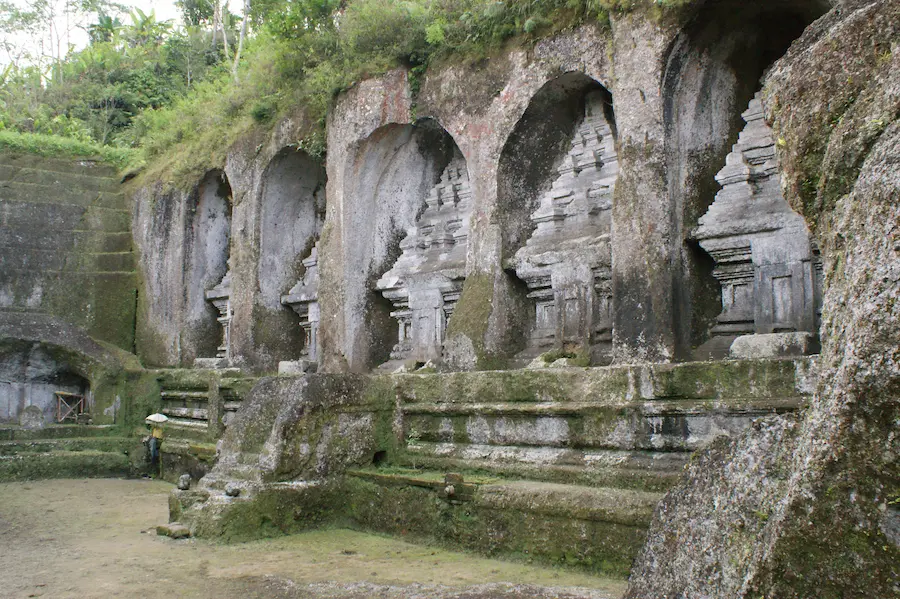
Discover Bali’s Ancient Temple Complex
Introduction to Gunung Kawi
Gunung Kawi is a captivating ancient temple complex in Bali, Indonesia. Located in Tampaksiring, this site offers a glimpse into Bali’s rich history. Carved into a river valley surrounded by lush greenery, Gunung Kawi is a serene destination.
Historical Significance
Dating back to the 11th century, it is believed to serve as a memorial to King Anak Wungsu and his favorite queens. The complex comprises 10 rock-cut candi (shrines) that stand majestically about 7 meters high.
Unique Features
The candi are carved into the rock face, resembling doorways to another dimension. This site combines natural beauty with architectural genius, showcasing Bali’s spiritual heritage.
Access and Best Times to Visit
It is accessible from Ubud by a 30-minute drive. The best time to visit is early morning to avoid crowds and experience the mystical atmosphere. The site requires walking down stairs, so comfortable shoes are recommended.
Surrounding Attractions
Nearby attractions include the Tirta Empul Temple, known for its holy water spring, and the scenic rice terraces of Tegallalang. These sites provide a full day of exploration in Bali’s cultural landscape.
Local Cuisine
Trying local cuisine is a must. Warungs (local eateries) offer traditional Balinese dishes. Babi guling (suckling pig) and ayam betutu (spiced chicken) are popular choices.
Events and Festivals
Bali’s calendar is full of cultural events and festivals. Visiting during Galungan, Kuningan, or Nyepi offers a deeper understanding of Balinese culture.
Gunung Kawi tours from Ubud
There are several tours available from Ubud. Full-Day Kintamani Gunung Kawi Private Chartered Car Tour from Bali has pick-up points in Kuta, Denpasar and Ubud.
The post Gunung Kawi appeared first on Find Asia - Tours in Asia.
Tirta Empul 17 Feb 2024, 11:08 am
Tirta Empul is a testament to Bali’s spiritual heritage. Its holy waters, rich history, and serene atmosphere make it a must-visit for anyone seeking to experience Bali’s spiritual side.
Tirta Empul: Bali’s Sacred Spring Temple
Introduction to Tirta Empul
Tirta Empul, located in the heart of Bali, Indonesia, is a sacred water temple. Known for its holy spring water, this temple is a significant spiritual site for Balinese Hindus.
Historical Background
Founded in 962 A.D., Tirta Empul is steeped in legend. The name means “holy water spring” in Balinese. According to mythology, the spring was created by the god Indra to revive his forces.
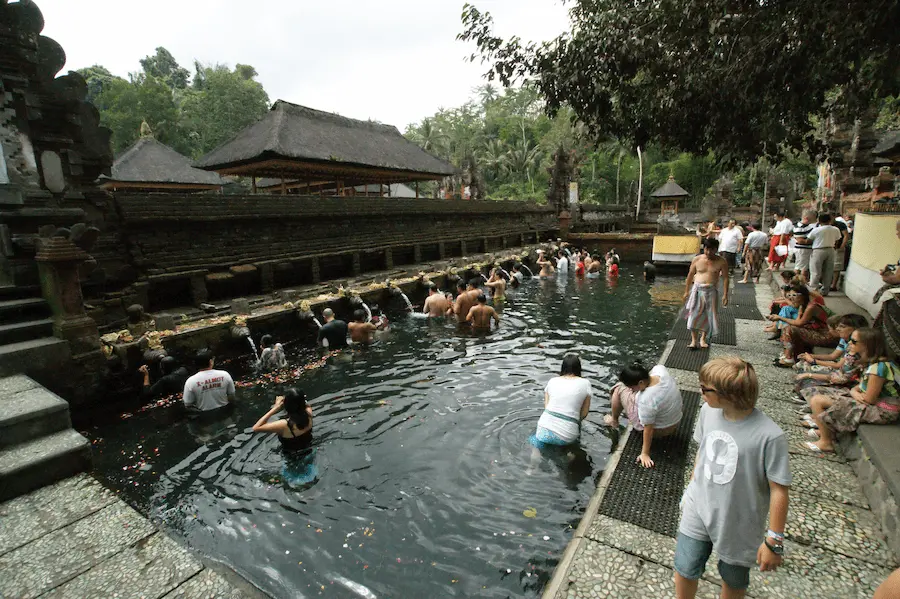
The Temple’s Structure
The temple complex is divided into three main areas: the outer courtyard (Jaba Pura), the middle courtyard (Jaba Tengah), and the inner courtyard (Jeroan). The Jaba Tengah houses the main attraction, the holy spring pools.
The Holy Springs
Visitors can observe the purification rituals in the spring pools. These rituals involve a series of immersions under the water spouts. People believe that the water has healing properties.
How to Visit
Tirta Empul is about a 20-minute drive from Ubud. The best time to visit is early morning when the temple is le. Sarongs are available for rent at the entrance.
Cultural Insights
Participating in or observing the purification ritual offers a unique insight into Balinese Hindu practices. The experience is both spiritual and refreshing.
Nearby Attractions
Close to Tirta Empul, visitors can explore the presidential palace, Tampaksiring Palace. The rice terraces of Tegallalang and Gunung Kawi temple are also within a short drive.
Local Eats
Nearby warungs (local restaurants) and cafes offer delicious Balinese cuisine. Don’t miss trying a traditional meal like nasi campur, a mixed rice dish with various sides.
Festivals and Events
Visiting during a Balinese Hindu festival, such as Galungan or Saraswati, adds to the experience. The temple is lively with devotees and rituals.
Tours
Skip the Line Tirta Empul Temple Entrance Ticket All Inclusive Tour departs everyday from Ubud. This is an inexpensive tour to visit Tirta Empul.
The post Tirta Empul appeared first on Find Asia - Tours in Asia.
Ubud in Bali Island 17 Feb 2024, 8:46 am
Ubud is more than a destination; it’s an experience. It embodies the essence of Bali through its art, nature, spirituality, and community. A visit to Ubud is a journey into the heart of Balinese culture.

Ubud: The Cultural Heart of Bali
Introduction to Ubud
Nestled in the uplands of Bali, Indonesia, it is renowned as the island’s cultural hub. It’s a haven for arts, crafts, and traditional dance. Surrounded by rainforests and terraced rice paddies, Ubud offers a serene and enchanting experience.
Cultural Richness
This place is home to numerous art galleries and craft shops. The Puri Lukisan Museum and the Blanco Renaissance Museum showcase Balinese art. Traditional dance performances, like the Legong and Kecak, enchant visitors nightly.
Natural Beauty
The area’s natural landscapes are breathtaking. The Tegalalang Rice Terrace offers stunning views of lush greenery. The Monkey Forest, a sacred nature reserve, is home to hundreds of monkeys. Ubud’s waterfalls, like Tegenungan, provide refreshing escapes.
Spiritual Sites in and around Ubud
This region is dotted with Hindu temples and shrines. The Saraswati Temple, with its beautiful lotus pond, is a must-visit. The Goa Gajah, or Elephant Cave, is an ancient site of meditation.
In the areas surrounding the town, Yeh Pulu stands as a testament to Bali’s rich cultural tapestry, offering insights into the island’s history and spiritual heritage.
Yoga and Wellness
Ubud is a center for wellness and yoga. Many retreats offer programs for physical and spiritual healing. Organic cafes and health-focused eateries complement the wellness lifestyle.
Market and Cuisine
The Ubud Market is a vibrant place to find handicrafts, textiles, and souvenirs. Balinese cuisine, with its complex flavors, is a delight. Warungs (local eateries) serve dishes like Babi Guling and Bebek Betutu.
Adventure Activities
Beyond culture and relaxation, it offers adventure. Whitewater rafting on the Ayung River is popular. Cycling tours explore the countryside, revealing hidden gems of Balinese life.
Access and Accommodation
It is easily accessible from Bali’s Ngurah Rai International Airport. There are regular bus services. Hiring a private car is also not so expensive.
A range of accommodations is available, from guesthouses to luxury resorts.
Tours
There are so many types of tours available here. From town walking, foodies, adventure in nature, religious places, local culture, etc. Ubud Tour – Best of Ubud – All Inclusive is one of the best tours.
The post Ubud in Bali Island appeared first on Find Asia - Tours in Asia.
Mount Kinabalu tours 15 Feb 2024, 5:52 am
Mount Kinabalu offers an unparalleled adventure. Its breathtaking landscapes, rich biodiversity, and cultural significance make it a must-visit. Whether you’re an avid climber or a nature lover, Kinabalu provides an unforgettable experience.
Discover the Majestic Mount Kinabalu: A Jewel of Borneo

Introduction
Mount Kinabalu stands as Borneo’s towering pride. Located in the Malaysian state of Sabah, it’s the highest peak in Southeast Asia. Rising to 4,095 meters, it attracts climbers from around the globe. The mountain is the centerpiece of Kinabalu Park, a UNESCO World Heritage Site. It boasts a rich biodiversity, including many endemic species.
Climbing Mount Kinabalu
Climbing Mount Kinabalu is a highlight for many adventurers. The journey typically spans two days. The first day involves reaching Laban Rata. Climbers rest here before the final ascent early next morning. The climb does not require technical skills, making it accessible to many. However, physical fitness is crucial. The view from the summit at sunrise is unforgettable, offering panoramic vistas of Borneo.
The starting point for climbing this mountain is Kota Kinabalu. Most climbing tours depart from Kota Kinabalu. A two-day tour with an overnight stay at a lodge on the way is common. Examples include 2D1N Mount Kinabalu Climbing. These tours include a guide, porters, and meals.
Flora and Fauna
The mountain is home to a diverse range of flora and fauna. As you ascend, the vegetation changes dramatically. From tropical rainforests at the base to alpine meadows near the peak. It’s a haven for botanists. Rare orchids, pitcher plants, and the iconic Rafflesia can be found. The park is also a birdwatcher’s paradise, with many endemic bird species.
Best Time to Visit
The best time to climb Mount Kinabalu is between March and August. This period offers the clearest weather conditions. However, the mountain can be climbed year-round. Visitors should prepare for rain and cold temperatures at higher elevations.
Access and Accommodation
Kinabalu Park is about 90 minutes from Kota Kinabalu, the state capital. Regular buses and taxis connect the city to the park. Accommodation ranges from mountain huts to comfortable lodges in the park. Booking in advance is essential, especially for climbing permits and mountain guides.
Cultural Significance
This mountain is sacred to the local Kadazandusun people. They believe the spirits of their ancestors reside on the mountain. The annual Kaamatan festival includes rituals to honor these spirits. Visitors are reminded to respect the mountain’s cultural importance.
The post Mount Kinabalu tours appeared first on Find Asia - Tours in Asia.
Phong Nha Cave tours 15 Feb 2024, 4:46 am
Phong Nha Cave is not just a natural wonder but also a symbol of Vietnam’s rich cultural heritage. Its preservation and the sustainable tourism practices around it reflect the country’s commitment to protecting its natural treasures.
Discover Phong Nha Cave: Vietnam’s Natural Wonder
Located in the heart of Phong Nha-Ke Bang National Park in Vietnam, this cave stands as a captivating testament to nature’s artistry. This remarkable cave is part of a UNESCO World Heritage site known for its geological value and stunning beauty. Its rich history, unique geological formations, and the adventurous experiences it offers make it a must-visit for travelers to Vietnam.

A Journey Through Time and Nature
This Cave is renowned for its impressive length of over 7.5 kilometers, though tourists are usually allowed to explore the first 1.5 kilometers by boat. Inside, the cave reveals a magical world with stalactites and stalagmites shaped over millions of years. The Son River flows through the cave, adding to its mystical ambiance.
A Gateway to Adventure
Visitors can embark on boat tours to witness the cave’s interior beauty. The journey starts at the mouth of the cave, where the river enters, creating a serene setting for exploration. The cave’s natural formations, including its famous “Lion” and “Buddha” stalagmites, leave explorers in awe.
Accessing Phong Nha Cave
Reaching Phong Nha Cave is straightforward. It’s located about 500 kilometers south of Hanoi. Visitors can travel by bus, train, or plane to Dong Hoi, the nearest city, and then take a short bus or taxi ride to Phong Nha-Ke Bang National Park.
Tours from Dong Hoi City
The nearest town to the caves is Dong Hoi. Many tours leave from Dong Hoi. Phong Nha & Paradise Cave – 1 Day All Inclusive tour departs everyday. This is one of the most popular tour with a reasonable price.
Culinary Delights and Best Times to Visit
The local area offers delicious Vietnamese cuisine, with specialties like Banh Xeo and Pho sure to satisfy food lovers. The best time to visit the Cave is from February to August, when the weather is dry, making cave tours more enjoyable.
The post Phong Nha Cave tours appeared first on Find Asia - Tours in Asia.
4-Day Laos Tour from Vientiane to Luang Prabang 6 Dec 2023, 4:52 am
This tour is a classic Laos tour departing from Vientiane. Accommodations, meals and transport are all included in the price.
This tour is conducted almost everyday. So it is recommended to those who come to Vientiane by themselves and try to find a way to Luang Prabang.
The post 4-Day Laos Tour from Vientiane to Luang Prabang appeared first on Find Asia - Tours in Asia.
Halong Bay helicopter tours 11 Apr 2023, 7:05 am

Halong Bay is located in northern Vietnam, about 170 km away from the capital Hanoi. There are about 1,600 islands creating a magnificent view.
If you have enough time in Halong, I recommend you to take one of Halon Bay cruise tours.
But if you do not have enough time, then Halong Bay helicopter tour is an option. Helicopter departs from Tuan Chau Heliport (see google map) near Halong Bay.

However, after a helicopter crash, helicopter tours are halted.
Check the availability of Halong Bay Helicopter tours here.
The post Halong Bay helicopter tours appeared first on Find Asia - Tours in Asia.
Ba Na Hill tours from Da Nang, Vietnam 24 Feb 2023, 5:53 am
Several tours are conducted from Da Nang City to visit Ba Na Hill, which is located only 30 km away from Da Nang City. Many tours include the visit to famous Golden Bridge supported by gigantic hands. The most popular tour among them may be “Ba Na Hills with Golden Bridge Private Tour“, which also visits Sun World.
About Ba Na Hill

Ba Na Hill is a popular tourist attraction located in the Truong Son Mountains near Da Nang in Vietnam. It is a hill station and resort complex that was first established by French colonists in the early 1900s, but has since been extensively developed into a modern destination with a variety of attractions.
One of the main features of Ba Na Hill is its cable car system. It stretches for 5.8 kilometers and holds the Guinness World Record for the longest non-stop single-track cable car. The cable car takes visitors from the base of the mountain up to the resort complex at the top. It offers panoramic views of the surrounding mountains and forests.
At the top of the hill, visitors can enjoy a range of attractions, including amusement park rides, cultural exhibits, gardens, and temples. There are also several restaurants and cafes offering a variety of cuisine options.
Another popular attraction is the Golden Bridge, a pedestrian walkway that spans two hands of a giant stone sculpture. The bridge offers stunning views of the surrounding landscape and has become an iconic spot for taking photos.
Ba Na Hill is also famous for its cool climate. It is a welcome respite from the hot and humid weather of coastal Vietnam. Visitors can expect temperatures to be several degrees cooler at the top of the hill. So it is a popular destination for both locals and tourists.
Overall, it offers a unique blend of natural beauty, modern attractions, and cultural experiences. So it is a must-visit destination for anyone traveling to central Vietnam.
The post Ba Na Hill tours from Da Nang, Vietnam appeared first on Find Asia - Tours in Asia.
Nizwa day trip from Muscat 24 Feb 2023, 4:26 am
About Nizwa
Nizwa is the Old capital of Oman, a must-visit destination in Oman for anyone interested in history, culture, and natural beauty of this region of the world. It is located in the Ad Dakhiliyah region of Oman. It is known for its rich cultural heritage, beautiful forts, traditional souks, and stunning landscapes.
Tourist attractions include
Nizwa Fort: This is one of the most iconic landmarks of the city. The fort was built in the 17th century and has played a crucial role in the city’s history. It is an excellent example of Omani architecture and offers a stunning view of the city from its top.
Nizwa Souq: This is a bustling marketplace where you can find traditional Omani handicrafts, spices, and souvenirs. It is one of the oldest souqs in Oman and is known for its vibrant atmosphere and colorful shops.
Jebel Akhdar: Jebel Akhdar is a beautiful mountain range located near Nizwa. It is a popular destination for hiking and trekking enthusiasts and offers stunning views of the surrounding landscape.
Bahla Fort: Bahla Fort is a UNESCO World Heritage Site. It was built in the 13th century and is one of the oldest and most well-preserved forts in Oman.
Al Hoota Cave: Al Hoota Cave is a natural wonder. It is one of the largest cave systems in the world and offers visitors a unique opportunity to explore the underground world of Oman.
Nizwa day trip from Muscat
There are several day tours available from Muscat. Among them, “Nizwa Fort-Nizwa Souq-Misfah Al Arbyeen-Jebel Shams – Private Full Day Tour” is the most popular day trip from Muscat.
The post Nizwa day trip from Muscat appeared first on Find Asia - Tours in Asia.
Borobudur and Prambanan tours from Yogyakarta 15 Feb 2023, 6:48 am
Borobudur and Prambanan tours
Both Borobudur and Prambanan are accessible from Yogyakarta. Numerous tours are conducted from Yogyakarta. It is recommended to take 2 days and stay in Borobudur so that you can see sunrise from Borobudur.

Borobudur and Prambanan Tours from Yogyakarta City is an example of such tours.
About Borobudur Temple
Borobudur temple is a UNESCO World Heritage Site and one of the most important Buddhist monuments in the world. It is located in central Java, about 40 kilometers northwest of Yogyakarta.
The temple was built in the 9th century during the Sailendra dynasty and consists of nine stacked platforms, six square and three circular, topped by a central dome. It has over 2,500 decorative relief panels and 504 Buddha statues. All of them are carved from stone.
The temple was abandoned in the 14th century and remained hidden under layers of volcanic ash and jungle growth until it was rediscovered in the early 19th century by the British colonial ruler, Sir Thomas Stamford Raffles. It has since undergone several restorations, the most recent of which was completed in 1983.
The temple is not only a significant Buddhist monument but also a masterpiece of ancient architecture and art. The relief panels depict scenes from Buddhist scripture and everyday life in ancient Java, offering insight into the culture and beliefs of the Sailendra dynasty.
Borobudur temple is also known for its unique design, which is thought to represent the Buddhist cosmology. The base of the temple represents the earthly realm, while the upper levels represent the higher realms of existence.
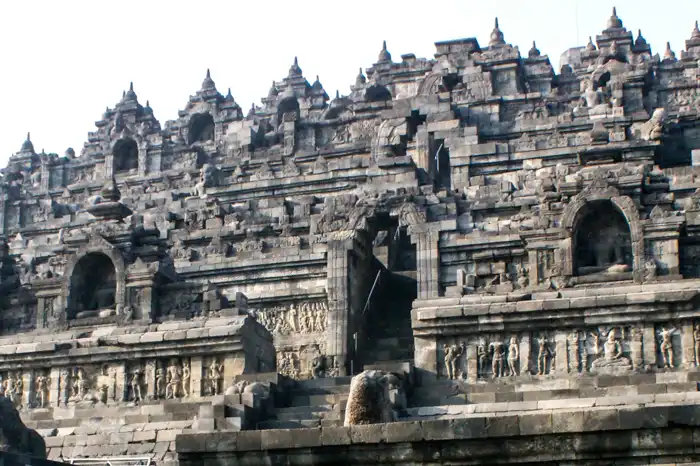
About Prambanan temples
Prambanan is a group of 9th-century Hindu temples located in central Java, about 17 kilometers northeast of Yogyakarta. The temples are considered to be the largest and most impressive Hindu complex in Indonesia and are designated as a UNESCO World Heritage site.
The complex consists of three main temples, known as the Trimurti temples, which are dedicated to the Hindu trinity of Brahma, Vishnu, and Shiva. The central temple, dedicated to Shiva, is the largest and most impressive of the three, standing at 47 meters tall. The other two temples are dedicated to Brahma and Vishnu and are located on either side of the central temple.
In addition to the three main temples, the Prambanan complex includes several smaller temples and shrines, as well as numerous pavilions and statues. The temples are decorated with intricate carvings and reliefs that depict scenes from Hindu mythology and everyday life in ancient Java.
Like Borobudur temple, the Prambanan complex was abandoned in the 14th century and fell into ruin. The temples were rediscovered and restoration work began in the early 20th century. Today, the Prambanan complex is a popular tourist destination and a symbol of Indonesia’s rich cultural heritage.
In addition to its historical and cultural significance, the Prambanan complex is also notable for its unique architectural style, which combines Hindu and Javanese elements. The temples feature towering spires, intricate carvings, and intricate stone masonry, making them a masterpiece of ancient architecture and art.
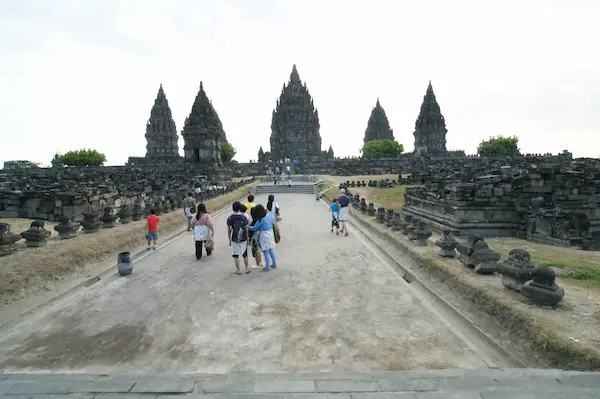
The post Borobudur and Prambanan tours from Yogyakarta appeared first on Find Asia - Tours in Asia.
Yeh Pulu tour in Bali 10 Feb 2020, 5:48 am
Yeh Pulu stands as a testament to Bali’s rich cultural tapestry, offering insights into the island’s history and spiritual heritage. It’s a must-visit for those seeking a deeper understanding of Balinese culture, away from the crowds.
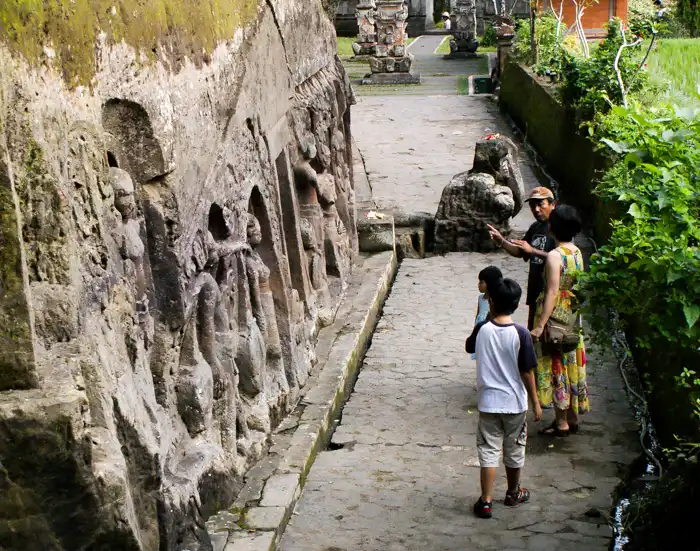
Explore the Enigmatic Carvings of Yeh Pulu
Nestled in the tranquil village of Bedulu near Ubud, Bali, this hindu temple offers a unique peek into the island’s rich past. This site, less visited than Bali’s famed temples, features an impressive stretch of bas-relief carvings. These artworks date back to the 14th century, showcasing scenes of daily life, mythical creatures, and Hindu deities.
A Journey Through Time and Nature
Accessing Yeh Pulu is an adventure itself. Visitors trek through lush rice fields and tropical forests, a scenic route that highlights Bali’s natural beauty. The path leads to the main attraction: a 25-meter-long series of carvings etched into a rock face. Historians believe these carvings tell stories of ancient spiritual practices and the Balinese way of life centuries ago.
Beyond the Carvings: A Cultural Experience
This place is more than its historic carvings. The site is surrounded by a serene environment, perfect for meditation or a peaceful stroll. Nearby, a small spring believed to have healing properties invites visitors to experience a part of Balinese spiritual tradition.
Practical Tips for Your Visit to Yeh Pulu
- Best Time to Visit: Early morning or late afternoon to avoid the heat and enjoy the area’s tranquility.
- Getting There: Yeh Pulu is located about a 15-minute drive from Ubud. Scooters are the preferred mode of transport, but local guides offer tours that include Yeh Pulu.
- What to Bring: Comfortable walking shoes, water, and a hat for sun protection.
Culinary Delights Nearby
After exploring, treat yourself to local cuisine at nearby warungs (small eateries). Ubud is renowned for its culinary scene, offering everything from traditional Balinese dishes to international fare.
Seasonal and Cultural Highlights
Visiting during the Galungan festival offers a unique experience, as the island comes alive with celebrations honoring the victory of dharma over adharma. Yeh Pulu, like many sites in Bali, is adorned with penjor (bamboo poles with decorations), adding to the festive atmosphere.
Yeh Pulu tours
There are many tours available to visit the temple. Many of them also visit Goa Gajah and/or Gunung Kawi.
The most popular one is “Best of Bali : Bali Temples , Rice Terrace and Waterfall Tour“, departing from Seminyak. Other tours depart from Kuta, Ubud, etc.
Yeh Pulu relief
The reliefs depict myths based on Hinduism. The stories progress from left to right.
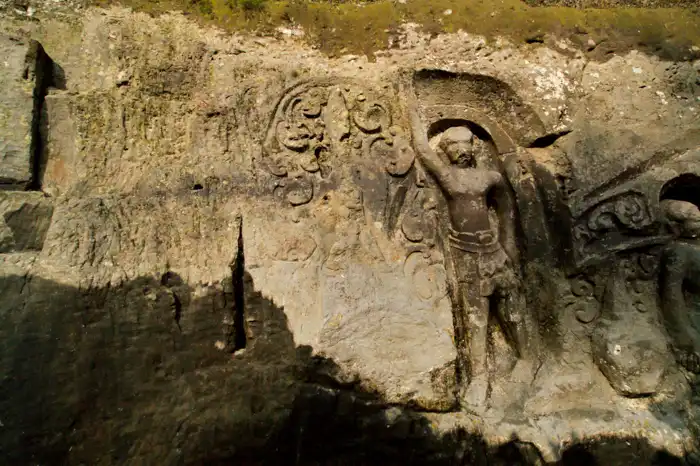
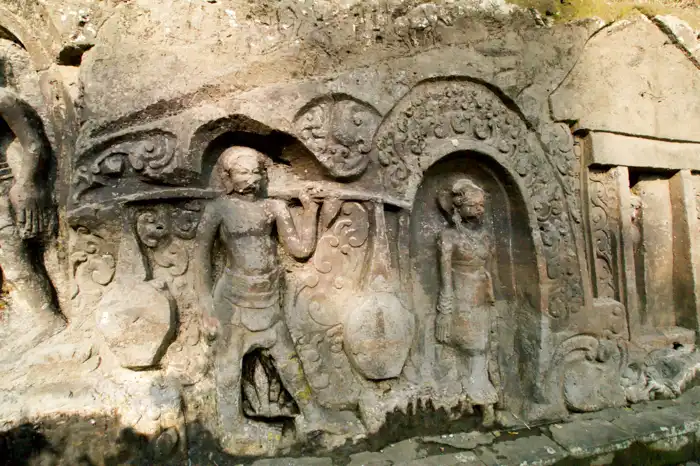
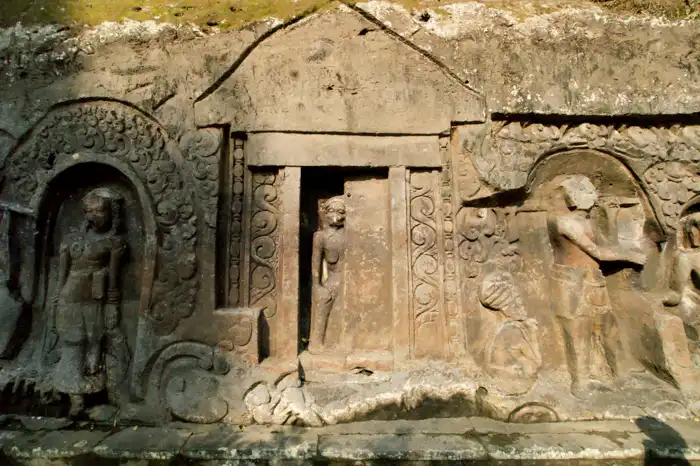

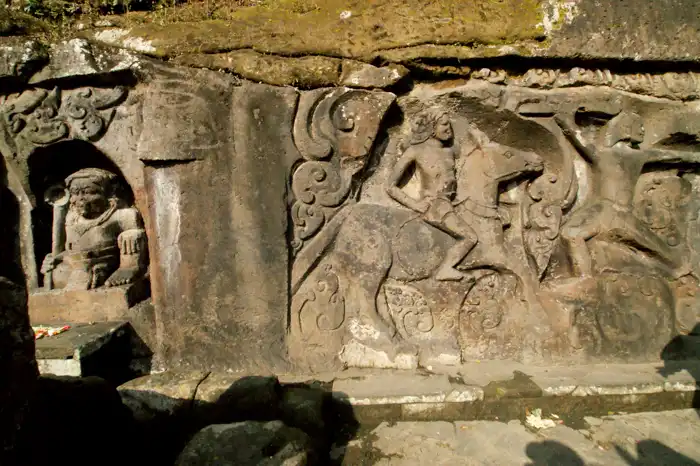
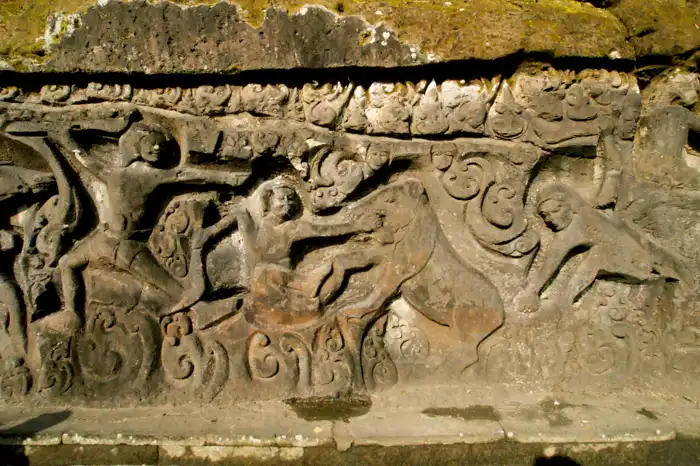
The post Yeh Pulu tour in Bali appeared first on Find Asia - Tours in Asia.
Everest helicopter ride and landing tour 4 Feb 2020, 7:29 am
Have you ever dreamed of close viewing of Mt. Everest? If you take a helicopter tour from Kathmandu, you can reach to Mt. Everest and land on Everest base camp.
There are several tour companies operating Everest helicopter tours. Most of them are shared flights, but some are private.
Of course, the price of the tour is not cheap but it can be one of your unforgettable memories.

Most popular helicopter ride tour
The most popular Everest helicopter ride tour is “Everest base camp helicopter landing group flight tour with breakfast at Everest“. This tour is conducted everyday. If there is no flight due to bad weather, there is a full refund. Hotel pick-up from major hotels in Kathmandu is provided, so you don’t need to go to the airport by yourself.
Note: this flight requires minimum of 5 passengers.
Popular helicopter ride tours
The post Everest helicopter ride and landing tour appeared first on Find Asia - Tours in Asia.
Halong Bay cruise tour 28 Jan 2020, 6:32 am
Halong Bay is a must-visit destination for nature lovers and adventurers. Its mystical landscape, rich biodiversity, and cultural experiences make it a unique journey.

Halong Bay: Vietnam’s Natural Masterpiece
Halong Bay, a UNESCO World Heritage site in northern Vietnam, is renowned for its stunning scenery. It features thousands of limestone islands rising from emerald waters. These islands are home to rainforests, creating a spectacular seascape.
Breathtaking Natural Beauty
The bay covers an area of about 1,553 square kilometers. It has approximately 1,960–2,000 islets. Many of these islets are uninhabited and untouched, offering pristine natural beauty.
Exploring Halong Bay
Cruises are the best way to explore Halong Bay. Options range from day trips to overnight stays. Kayaking and boat tours allow close encounters with the bay’s serene beauty.
Sung Sot Cave and Ti Top Island
Sung Sot Cave, or Surprise Cave, is a highlight. It’s one of the largest and most impressive caves in Halong Bay. Ti Top Island offers a beach and a viewpoint for panoramic views of the bay.
Local Cuisine and Culture
Seafood is a culinary highlight, with fresh catches served on many cruises. Floating villages like Cua Van provide insights into local life on the water.
Best Time to Visit
The best times to visit Halong Bay are during spring (March to May) and autumn (September to November). These months offer pleasant weather, ideal for cruising and outdoor activities.
Environmental Preservation
Efforts are ongoing to preserve Halong Bay’s natural beauty. Visitors are encouraged to support eco-friendly practices during their visit.
Tours
Many types of tours are available. The most enjoyable tours, however, are those that spend the night on board. There are tours that include a car pickup from Hanoi. For example, All-Inclusive OVERNIGHT Halong Cruises offers pick-up service in Hanoi. Cabins are air-conditioned and you can enjoy tasteful Vietnamese dishes on board.
The post Halong Bay cruise tour appeared first on Find Asia - Tours in Asia.
My Son tours from Hoi An or Da Nang, Vietnam 27 Jan 2020, 8:06 am

About Mỹ Sơn (My Son ruins)
Mỹ Sơn or My Son in English is a group of abandoned Hindu temples in Quảng Nam province, Vietnam. The site is a complex of Hindu temples and towers. The Champa kingdom had built them between the 4th and 14th centuries.
The Champa people were a civilization. It existed in central and southern Vietnam from around the 2nd century until the 19th century. Indian culture and religion strongly influenced them, and their architecture and art reflect this influence.
Mỹ Sơn was an important religious and cultural center for the Champa people. And the site includes around 70 structures, including temples, towers, and sanctuaries. Many of these structures were built with brick and decorated with intricate carvings and sculptures.
The site was designated a UNESCO World Heritage Site in 1999. And now it is a popular tourist destination in Vietnam. However, the site has also suffered damage over the years due to natural disasters and human conflict. It includes bombing during the Vietnam War. Restoration efforts have been ongoing, but the site remains vulnerable to further damage.
Visitors to Mỹ Sơn can explore the temples and learn about the history of the Champa civilization. The site also hosts cultural performances that showcase traditional Champa music and dance.
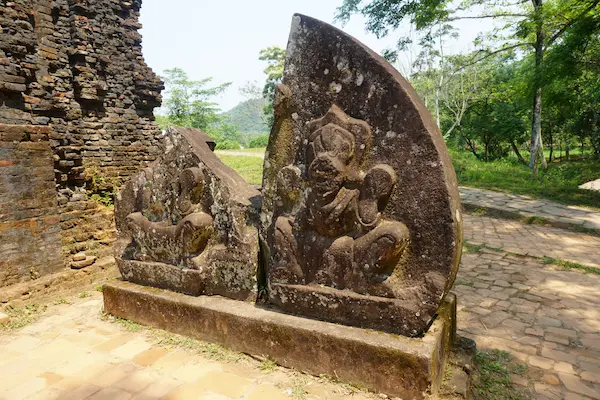
Popular tours
My Son is accessible by tours from Hoi An or Da Nang. Several tours depart daily. Or you can just use car transport from Hoi An/Da Nang.
The most popular tour is “Private Day Trip to do My Son Holyland & Hoi an city Tour from Hoi an or Da Nang“. This tour is available for from 2 pax everyday.
Transfer services to My Son
Tours to My Son
The post My Son tours from Hoi An or Da Nang, Vietnam appeared first on Find Asia - Tours in Asia.
Beng Mealea Tour from Siam Reap 27 Jan 2020, 7:02 am
Discover the Mysteries of Beng Mealea: Cambodia’s Hidden Jewel
Nestled in the Cambodian jungle, Beng Mealea temple remains a hidden gem. Less known than Angkor Wat, it offers a unique glimpse into the past. This temple, overgrown by nature, feels like stepping into another world.

The History and Charm of Beng Mealea
Built in the early 12th century, Beng Mealea predates many of Angkor’s famous temples. Historians believe it served as a model for Angkor Wat. Its name means “Lotus Pond,” reflecting the serene beauty surrounding it. Unlike many Angkor temples, Beng Mealea’s creator remains a mystery. This adds to its allure.
Exploring the Ruins
Visitors to this temple navigate through a maze of rubble and dense foliage. Massive sandstone blocks lie scattered, entwined with roots. The temple’s layout mirrors that of Angkor Wat. However, its untouched appearance offers a more adventurous exploration.
How to Get There
It is about 40 miles (50 km) east of Siem Reap. The journey takes around an hour by car. Hiring a guide or taking a tour is recommended. They can provide insights into the temple’s history and help navigate its ruins.
Why Visit Beng Mealea
It stands out for its raw beauty and tranquility. It’s ideal for those seeking adventure off the beaten path. Photographers and history buffs will find endless inspiration among its ruins.
Tips for Visiting
- Go early to avoid crowds and enjoy cooler weather.
- Wear sturdy shoes for navigating uneven terrain.
- Consider a guide for a richer experience.
Nearby Attractions
Siem Reap, the gateway to Angkor, is the closest city to Beng Mealea. After exploring the temple, consider visiting the iconic Angkor Wat or the enchanting Ta Prohm temple.
Beng Mealea tours
The most popular tour may be “Featured Private Angkor Wat Tours, Bayon, Ta Prohm, Bantey Srei And Beng Mealea” from Siam Reap. This tour is available almost everyday.
Tours from Siam Reap
Several tours are conducted from Siam Reap. There are also some tours that combine with Koh Ker tours.
There are half day tours, or 2-3 days adventure tours, or tours combining with other places such as Angkor Wat, Banteay Srei, Koh Ker and other destinations. Some tours listed on Viator/Trip Advisor are shown below. For all available tours, follow this link.
The post Beng Mealea Tour from Siam Reap appeared first on Find Asia - Tours in Asia.
Angkor Wat sunrise tour from Siam Reap 26 Jan 2020, 2:14 am
sunrising over the temple
The best time in a day to see Angkor Wat is at sunrise. Sunrise tours from Siam Reap provide you with the magnificent view of Angkor Wat in twilight and sunrise, if there is no cloud. Hotel pick up is provided, though you have to wake up quite early to see Angkor Wat in the light of sunrise.
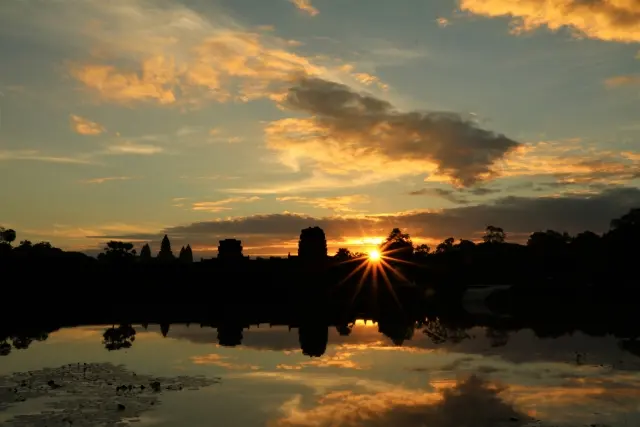
The most popular tour
Explore Angkor Wat Sunrise Small Group Experience is the most popular Angkor Wat sunrise tour from Siem Reap. Free pick up & drop off service from your hotels in Siem Reap is provided.
Other tours
Many tour companies provide sunrise tours. Choose the one best suit to your preference.
The post Angkor Wat sunrise tour from Siam Reap appeared first on Find Asia - Tours in Asia.